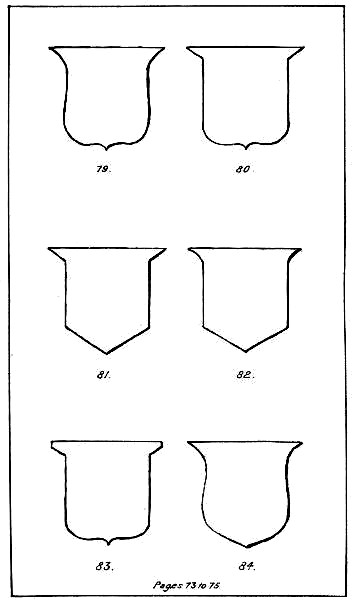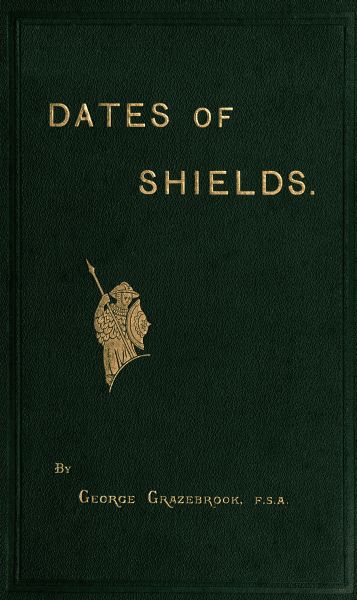

FIFTEENTH-CENTURY SHIELD
(Hewitt's Ancient Arms and Armour, vol. ii, p. 496).
The DATES of
Variously-shaped SHIELDS,
with coincident DATES
and EXAMPLES.

Enlarged
from a Paper read before
the Historic Society of
Lancashire and Cheshire.
Ἀνεδέχθη μὲν γὰρ ἄσπις.
(Herod. vi. 124.)
BY
George Grazebrook, F.S.A.
LIVERPOOL:
PRINTED FOR PRIVATE CIRCULATION.
1890.


PREFACE.
In venturing to place before the public this little work—which takes up a line of enquiry never before attempted,—I would solicit criticism, not of that slashing condemnatory kind which destroys a statement without pointing out its correction;—that would only break my head, and make no one the wiser!—but I hope that antiquaries who have more knowledge than I, may, when pointing out errors, also explain what such statements ought to be, and give exact references in proof.
With the help of such criticism (and the more severe, the more valuable it will be) I trust that another perfected issue, by myself, or by some other more qualified writer, may eventually appear as a handbook—most useful to the student, the antiquary, and the traveller.
It is now a subject for much regret to all of us that the great knowledge of seals (the chief source of evidence as to ancient shields) acquired by the late Mr. Albert Way, F.S.A., and by the late Mr. Charles Spencer Perceval, F.S.A., has passed away with them, never having been recorded; and it seems very desirable that a classified body of such knowledge should be drawn up and available—enabling us to date with some certainty (within the limit of a few years) seals pendant to undated charters, stone carvings on ancient buildings, and illustrations in MSS., which are now labelled "circa."
In the course of my researches I have noticed a number of cases where incorrect dates have been supposed,—and from some of these deductions have been drawn, which are consequently all wrong.
In the following treatise each century from the eleventh to the fifteenth is separately dealt with; after that date the nomenclature of shields devised by my friend Mr. J. Paul Rylands, F.S.A., is followed, and the earliest and latest examples found of each shape adduced,—thus showing the range of time when that variety was most commonly in use. References are given for every statement.
Mantlings, torces, wreaths, palm branches, and other adjuncts are discussed under their several headings—with descriptions and dates of any varieties found.
In conclusion a concise index is given, which, it is hoped, sufficiently focuses the whole book for ready reference.


AN ATTEMPT TO CLASSIFY AND DATE THE VARIOUS SHAPES FOUND IN HERALDIC SHIELDS—PRINCIPALLY IN ENGLAND, WITH INCIDENTAL DATINGS.[1]
It seems necessary, by way of introduction, to say a few words on the circular convex shields used from very early times by our Saxon and Norman ancestors. These were of wood, with a central boss of bronze, and were sometimes of very large size; frequently, if we may judge from contemporaneous illuminations, as much as four feet in diameter. Across the inside of the boss a handle was fixed, and the shields, which were thus held out almost at arm's length, as represented[2] in many ancient MSS., must have been most cumbersome. It is hard to see how the sword or lance could have been conveniently used. The round shape must have interfered greatly with the view of one's opponent, and a bungler would inevitably slice pieces from off his own shield while attacking his enemy. Moreover, such shields must have been lightly made: we know exactly how the bosses were fastened with rivets through the shield, for they are constantly found in Anglo-Saxon grave mounds, and the wood is thus known to have been of some thickness. But we can obtain from contemporary writings many more particulars.
By the laws of Gula [said to have been established by Hacon the Good, who died 963] any possessor of six marks was required to furnish himself with a red shield, of two boards in thickness, a spear, and an axe or a sword.
In the history of the same king [Heimskringla, vol. i, p. 155] he is thus described: "he put on his tunic of mail (brynio), girded round him his sword called quern-bit [i.e., millstone-biter], and set on his head his gilded helmet. He took a spear in his hand, and hung his shield by his side."
Again, in the same book [Heimskringla, ii, 352], in the description of the Battle of Sticklastad, where Olaf King of Norway, called "the Saint," was slain 1030, the monarch is said to have worn a golden helmet, a white shield, a golden hilted and exceedingly sharp sword, and a tunic of ringed mail ("hringa brynio").
Again, in the Edda Gunnar one of the Reguli of Germany says, "My helmet and my white shield come from the Hall of Kiars."
These quotations are hardly sufficient evidence of it perhaps, but it seems as if in the tenth[3] century white shields were borne by leaders and red ones by the common soldiers,—every one who possessed six marks.
Supplementing these and completing our description, Saxon poetry tells us that the wood was by preference the lime tree. I need not give quotations; they will be found in the several works on ancient arms and armour. Beowulf [line 5215] describes how Wigluf "seized his shield—the yellow linden wood." Again, these lines occur [Poem of Judith, Thorpe's Analecta, p. 137]:—
"The chieftains to the war
"Protected with targets,
"With arched linden shields."
It seems almost as if linden trees were cultivated with this view, for the Saxon Chronicle, under anno 937, tells us how King Athelstan and his heroes
"And hewed the war lindens."
But certainly on one occasion remains of oak timber were found in connection with the bronze boss of an Anglo-Saxon shield.
Occasionally rims of metal have been found with such remains, but such protecting edgings do not seem to have been the usual custom. The laws of Gula, quoted above, mention "two boards in thickness," that is, glued crossways, to prevent warping or splitting. Such a formation in a convex shield would show a very great amount of skill in the working of wood at this early date. Leather seems to have been sometimes stretched over the shield; because the laws of Athelstan forbade the use of sheepskins for the purpose, under a penalty of 30s.: a very large sum. Had skin coverings been common, remains of such skins[4] would be found still attached inside the bronze bosses; but only one skin-covered shield has been found [at Linton Heath, in Cambridgeshire], and in that the skin covered the boss also, having been stretched over the whole shield.
Lastly, red seems to have been at least a favourite colour, for Sœmund's Edda mentions a red shield with a golden border, and Giraldus de Barri says the Irish "carried red shields, in imitation of the Danes."
The boss was often carried out into a sharp spike, and the shield could thus be used for offence as well as for protection. But perhaps such points were also found of use in stopping the cut of a sword, which might otherwise slip down the shield and find a resting-place in the leg or other exposed part.

Date 1473.
We shall see as we proceed that such circular shields or targets constantly appear till the middle of the seventeenth century, borne by foot soldiers, with pikes, halberds, and swords, and sometimes as large as two feet in diameter. Frequently foot soldiers are represented with a small target, ten or twelve inches in diameter, wherewith to receive their[5] opponent's cut, while the other arm wields a huge broadsword. Such were in later times called "targetiers." Their small targets were hooked to the side when not in use, and one is represented in 1473 which projects to a point (Hewitt, ii, 488), while others are flat and studded with nails, or otherwise ornamented, such as appear among the Scotch and Irish till a much later date. Small shields of a square form, and ten inches square, were used by fencers with rapiers in the sixteenth and seventeenth centuries.
Such is a hasty sketch of the circular shields. They were used by all ranks of the Saxon nations—among whom, of course, were those we call Normans—to the end of the tenth century.
Fitness for the purposes of defence is the prime governing law in such matters. We shall see this leading to many strange alterations of shape in after centuries, and, at the date at which we have now arrived, (the first half of the eleventh century,) a perfect revolution in the appearance of shields took place within a space of about fifty years.
Meyrick explains how the Normans who were engaged in the conquest of Apulia, in the south-east of Italy, about the beginning of the eleventh century, learned there the advantages of long and narrow shields, such as were then in use among the Sicilians, and states that about fifty years before the battle of Hastings they received from Melo, the chief of Barri, supplies of such vastly improved arms. The intimate relations with Normandy at that time, and under Edward the Confessor, led to their prompt adoption in England also; and hence in the Bayeux tapestry kite-shaped shields No. 3 are universal among horse soldiers, both Anglo-Saxon and Norman. Some Saxon foot soldiers bear the old round shields, and one square-shaped one appears on that roll.
There is a very amusing picture of Harold and his companions proceeding, in company with William of Normandy, to the conquest of Britanny. They came to the little river Coësnon, where, the tide being out, the river-bed was an expanse of slippery mud. The prudent ones dismounted and led their horses across; but one horse is represented coming down and the rider falling over his head, while his shield flies through the air attached to his neck by the guige [Bruce's Bayeux Tapestry, p. 61]. This "guige" was another most valuable improvement which probably came from Sicily with the new shape of shields. It was a leather strap sufficiently long to let it hang from the neck, and so, when two hands were required to wield a battle axe or heavy weapon, the shield could be flung loose and recovered again. I am aware that in Cotton MS. Cleopatra, cviii, written early in the eleventh century, a group of Saxon horsemen is represented on a journey, and the round shield of one hangs from his back, looking like the beehive which the knight in Alice in Wonderland thought might some day prove useful. It has, it will be seen, an absurdly awkward appearance [Hewitt, vol. i, p. 77; Cutts, p. 313].

The principle, then, of the kite-shaped shields which we see in the eleventh century was that, with as much compactness as possible, they should protect the body with the wider part, while the extended point was sufficient to defend the leg; and following so nearly the shape of the body the knight had his sword-arm free. They seem to[7] have been five feet long or even more, for they served as a bier whereon to carry away the slain or wounded.[2] It is amusing to see Goliath represented with a kite-shaped shield, while the little David on the top of him tries to wield his huge sword. This appears in a Latin Bible of 1170. [Brit. Mus., Add. MS. 14789, fo. 10; engraved, Hewitt, i, 134.]

A remarkable recrudescence of old ideas both in the shapes and sizes of shields occurs from time to time as we proceed. At times they seem to have been nearly as much as five feet long—and then, as protective mail became more perfect, and probably the varying style of fighting required it, they were greatly reduced. King David and his followers appear [Cutts, p. 335], on their expedition against Nabal, in full mail of the end of the thirteenth century, with shields scarcely eighteen inches long—just sufficient to prevent the point of a[8] lance reaching some flat or dangerous or vulnerable spot from whence it would not readily glide off, or to receive the blows of an assailant's sword. Nor can we suppose that one scale of size, or indeed one exact shape of shield, reigned universal at any one period; every knight had his own fancies as to which best suited him; and at length we find many illuminations of the sixteenth century in which knights appear jousting and fighting without any shields at all. They were hung up, to show the heraldry, on their tents, and the massive body-armour alone was considered sufficient protection.
These few explanatory words are necessary to introduce upon the scene the various shaped shields occurring during the centuries which follow. While considering these variations we must bear in mind that they are strongly marked into two great divisions, viz., before the sixteenth century, when shields were in actual use and any alteration in their outline was considered to be an improvement to meet some freshly noticed want; this will be further referred to as instances occur. During and after the sixteenth century, shapes were selected in an arbitrary way, as a matter of taste alone; and hence earlier examples were sometimes exactly adopted, while at other times details and alterations were introduced, just to suit the fancy of the purchaser or artist and the conventional style of the times.
As references for what has already been said, I would name the works of Meyrick and Hewitt, Planché's work on Costume, Strutt's Horda, and a learned paper on shields, by Sir Frederick Madden, in Archæologia, vol. xxiv. This, although primarily discussing the chessmen found in the Island of Lewis, contains the results of wide researches as to shields in the eleventh and twelfth[9] centuries. There is also a valuable and well illustrated book, Scenes and Characters of the Middle Ages, by A. L. Cutts, published by Messrs. Virtue and Co., 1872.
The principal authority for the accurate dating and classifying of shields is the immense number of mediæval seals attached to deeds and charters, and with dates exactly known. If it were practicable to arrange in chronological sequence illustrations of a sufficient number of these, we should at once have the classification of dates, styles, and shapes, which would be so very valuable, and which it is the attempt of this paper to display. Hence it is that to the end of the fifteenth century seals form so large a part of the evidences submitted. The certainty of such records is unsurpassed: we have a parchment, itself dated, or the date of which in very early instances can be otherwise closely ascertained; and attached to this we have a seal with the shield; and, to make it perfectly certain, we have the owner's name inscribed around it, and so we know he is not using some one else's seal, found or come down to him from earlier times. Such instances frequently occur, and are at once in this way detected. There are instances where the same seal, acquired in early life, continued to be used for over fifty years; but that is the extent to which such valuable proofs can wander from the actual prevailing type and date.
Besides seals, the many invaluable illuminations in the British Museum and Bodleian Libraries, and in the great Continental Libraries, furnish numberless pictures of knights and their accoutrements, contemporaneously executed, and with the most manifest exactness in every detail. Many of these have been engraved in our popular literature, as well as in the learned works named above; but[10] to enable the mind to form correct conclusions these should be all cut out and arranged in groups of exact dates, or drawn as they are in a student's note book.
The earlier monumental effigies afford many valuable examples of shields, and after they cease to be represented by the side of the figure, such often appear among the architectural details, giving the shape of shield, with an exact date attached.
Monumental brasses give evidence to a later date, and the canopy work introduced often carries ornamental shields.
Architectural stone carvings frequently give data of great value. I need only refer to those put up in Westminster Abbey about 1260, which show the exact shape and proportions of some of the shields then used, and are represented as hanging by their "guiges" from stone projections carved into various devices. But representations in stone and in stained glass, especially those of later date, seem to be greatly influenced by their surroundings, and cannot therefore be implicitly relied on as proofs of style and date. They are often found not to correspond exactly with other examples; indeed it is a curious fact, which all my fellow students will vouch for, that these two—stone and glass—seem of all materials most liable to err. The good name of many a respectable family has been ruined by the bend sinister introduced through the ignorant determination of some stone-carver; while in glass, colours are altered, and impaled shields have been turned round and so reversed; while, in the particular subject under discussion, viz., the exact shapes of shields which obtained at various dates, we find in both stone and glass that their shapes follow the necessities of the rest of the design, and are made to fit into them.
Printed books supply many shields from the end of the fifteenth century, showing the artistic taste in such matters which prevailed from that date to the present. Printers' marks begin still earlier, and are often contained in shields; but these usually show a spirit of exaggeration, and convey the impression that such would not be found elsewhere, and hence they are not of much use to us in our present purpose of laying down exact dates.
Grants of arms and book-plates come in to continue our information, giving shapes and the decorations surrounding them. Book-plates are usually efforts of art and taste at the dates when they were executed, and these two occur just at the time when other evidences fall short, and so they are peculiarly valuable.
In the following remarks I shall gladly avail myself of the new system of nomenclature devised and introduced by my friend, Mr. J. Paul Rylands, F.S.A. I welcome it as a most valuable desideratum, by means of which I hope to make my subject intelligible. Without such a system a still greater number of illustrations would have been required, and I should like to bear my small testimony to its very great and, I expect, increasing usefulness. It is not everyone who has the ready hand to dash off the correct outline when seeking to communicate the style of a shield, or a book-plate, and here we have a simple alphabet of shapes which can be read and understanded of all men, and which will certainly be found so convenient that it will come into general use.
ELEVENTH CENTURY.

Our examples of shields show very few varieties, nearly all seem to follow the long kite shape or "Norman pear" Nos. 3 and 4. The great seals[12] of William I., William Rufus, and Henry I. all show this shield, also that of Ilbert de Laci [Archæological Journal, vol. iv, p. 249], while the Bayeux tapestry, worked at the end of this century, represents them exactly. Seeing, as we do in the seals of this date, which mostly represented mounted horsemen, the inside only, it may be noticed that all seem to be strengthened round their edges. In those of William I. and Ilbert de Laci a metal rim is shown; in that of William Rufus two of such strips, while in that of Henry I. rivets appear to fasten a similar rim on the other side. In the Bayeux tapestry some round shields with pointed bosses appear, and one of a square shape rounded at the corners.
In seals the lettering of the inscriptions is in plain Roman capitals, while longobardic letters for G E A and D appear sometimes, but in several seals preserved from this early date the inscriptions have unfortunately decayed away.

Gilbert de Gant, ob. 1156.
THE TWELFTH CENTURY

exhibits several varieties of shape, Norman and the Norman convex at the top (Nos. 1, 2, 3, and 4); and many of these are curved, so as to partially surround the body. The great seal of Stephen[13] represents a pointed boss and a shield almost pear-shaped. One very curious seal, that of Richard Basset, about 1145, merits a full description. He appears bearing a kite-shaped or very elongated pear-shaped shield (No. 3), about four feet long, and carried down to a sharp point. The top is bi-lobed, like a heart, and it is strengthened all round by a metal rim, while further strength is imparted by a boss or figure like a simple escarboucle, carried out to the sides. He wields a very powerful sword, with an extraordinarily heavy hilt, and with it he cuts off the large duck-like beak of a formidable rampant-winged animal like a dragon, and, apparently, thus frees a human figure held in its beak. This curious seal is attached to a charter printed in Blomefield's History of Norfolk (see No. 44). The seal of Gilbert de Gant, who[14] died 1156, presents a shield more triangular than No. 2, and in the centre is a sharp pointed boss [Top. and Gen., i, 317]. The same boss appears in the seal of Ralph son of William, of Dimsdale-on-Tees, 1174-80 (Herald and Genealogist, i, 227); also in a good many contemporaneous seals, and it was evidently meant for use as an offensive weapon. It is noteworthy that on the first seal of Richard I. a spike is shown on the shield; his first coronation was in 1189. On the second seal there is none; his second coronation took place on 17th April, 1194. This may show the date when this fashion was discontinued. In the seal of Sewal de Ethindon, about 1167, the curved shield of Norman form, No. 2, runs down into a long point, somewhat twisted round, so as to show down on the right side of the rider. It does not protect his leg at all; in fact, the arrangement, to our eyes, seems awkward and most embarrassing to the mounted knight (engraved Nicholas Upton, p. 84; see No. 45). While in that of Sayer de Quinci, towards the end of this century, a heater-pear shield No. 6 appears. This is engraved in Spelman's Aspilogia, p. 67.
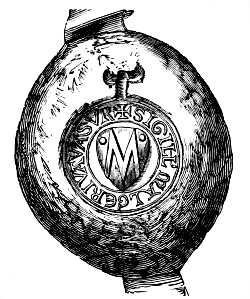
The men's seals of this date which present their shields for our consideration usually show them on horseback, fully caparisoned; and many interesting details of spurs, swords, and arms are represented, as well as the furniture for their horses. We are able here to show the two seals of Malgerus le Vavasour, 1140-50, showing heater-pear, almost heart-shaped shields. See Collect. Topog. et Genealog., vol. vi, p. 127, where the deed to which these are attached is supposed to date between 1180-6; but Malger's son, William Vavasour, was a judge 1166-84 [Itinerary of Henry II.], and Sir Robert, the grandson, paid a heavy fine—1200 marks and two palfreys—in 9 John, 1207-8, that Maud his daughter [and widow of Theobald Walter] might marry Fulke Fitzwarine: we have thus no difficulty in proving that the date of this seal is circa 1140 to 1150. We also give the beautiful seal of Egidius de Gorram, 1175-80 [16][Collectanea Topog. et Genealog., vol. v, p. 187.] The unmounted knight is represented in scale armour, kneeling, and holding a sort of heater-pear shield, No. 6, with a pointed boss.
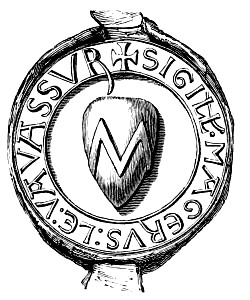
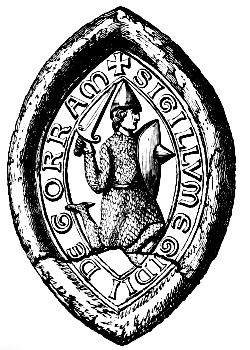
The fields of seals are now quite plain, except sometimes in those of ladies. In the first seal of Roheis de Gant, Countess of Lincoln before 1156, lilies are introduced, to fill up what would otherwise appear too great a bare space. This is engraved in Topog. and Genealogist, vol. i, p. 318.
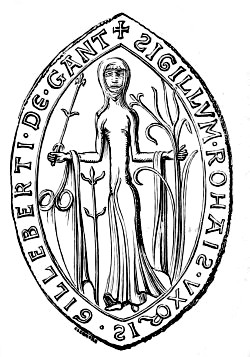
In counterseals of this century heater shields appear such as are common during the next century. A most curious instance of a pear-shaped curved shield, having a bouche cut into it for the introduction of the spear, occurs in the seal of Theodoric Count of Flanders, 1159, who wears tegulated armour. It is engraved in Oliver Vredius, p. 17 (see No. 46). So far as we know, this useful bouche, as a resting place for the spear, disappeared—to[17] crop up again, as an improvement and novelty, in the middle of the fourteenth century.
The marvellous set of chessmen found in the Isle of Lewis afford us a most interesting series of shields of this century. They are fully illustrated, Archæologia, vol. xxiv. They give us the long Norman pear or kite-shaped No. 3, the Norman convex No. 4, also a flattened convex with rounded corners, and these shields are all long and narrow, just wide enough to cover the body. There are many instances of exactly similar shields. In Harl. MS. 2803, a Bible, written about 1170, Goliath of Gath bears a shield exactly resembling them; and in the most interesting monumental effigy of William, Count of Flanders, son of Robert, Duke of Normandy, who died in 1127, engraved in Oliver Vredius' Seals of the Counts of Flanders, 1639, p. 14. He apparently was a very old man at his death. He bears a shield exactly like the Lewis chessmen in shape, but the face of it is filled up with an elaborate escarboucle, carried[18] out and attached to the rim, which wholly surrounds the shield. Shields with the flattened convex top and rounded corners, but of much shorter proportions, occur in Harl. MS. Y. 6. (engraved Hewitt, vol. i, p. 127), written at the end of the twelfth century, and one clearly shows the curved formation which is indicated in numberless seals and illuminations of this date.
The inscriptions are in Latin and in longobardic characters, but Gothic letters are sometimes alternated, while in others plain Roman capitals still occur. I have noticed one remarkable instance of an inscription of this century, in Norman-French, around the seal of Alanus fil. Adam, temp. Henry II. The deed to which it is attached is printed in Collectanea Topographica et Genealogica, vol. v, p. 116.
THIRTEENTH CENTURY.
In the earliest years of this century Norman shields curved round the body still continue; while in seals, which at this date are our principal source of evidence, animals, such as dragons, appear to fill up the field, and especially to support a plain shield in large counterseals; also distinctive badges are introduced, such as cinquefoils, estoiles, mascles, boars' heads, lions, &c.; but sometimes in character they follow greatly the pattern obtaining at the end of the twelfth century. "Heater-pear" No. 6 occurs, and frequently such a shield stands in the centre of a circular seal, merely surrounded by the inscription in longobardic. The heater shield is now rather more pointed than it appears in later examples.

A very curious triangular shield No. 1 also now appears, as in the seal of Johannes fil. Galfridi[19] de Edinton, such a triangular shield on a plain circular field, around which is the inscription, in plain Roman capitals. This is engraved in the Visit. Hunts., 1613, p. 100. Another seal, Nigellus de Amundeville, is entirely three-cornered, a little longer than an equilateral triangle; the shield is of the same contour, and shows three chevrons, while the edging leaves space for the inscription round the three sides. This is also engraved in the Visit. of Huntingdon, 1613, p. 121, published by the Camden Society. This shape of triangular seal seems to have been more common than was supposed. The curious seal of the Treverbin family of Cornwall is engraved, Archæological Journal, vol. x, p. 150; but, as it shows no shield, it stands outside our present subject.
Another curious shield is figured in Nicholas Upton, De Usu Militari, Bisse edition, 1654, p. 37, and of date 1257 (see No. 47). Henry de Fernbureg stands with a square shield in his left hand. It is about two feet long, considerably curved, and appears to be very thick. In his right hand he holds a hammer extending into a sharp spike at the back. Square shields very much like this, but more oblong in shape, and with a round boss projecting from the middle, occur in the very curious illustration of a wager of duel in the Miscel. Rolls, temp. Henry III., and therefore of date 1210-50. Each duellist carries such a shield; they must be over two feet long, and are much curved; while with the other hand he wields an awkward looking hammer, or more properly a pick, as it is pointed at both ends; while, after the manner of ancient pictures, the vanquished (and therefore the guilty one) is seen hanging up in the background. This is engraved in Hewitt's Ancient Armour, vol. i, p. 375, also in Madox's History of the Exchequer, p. 383.
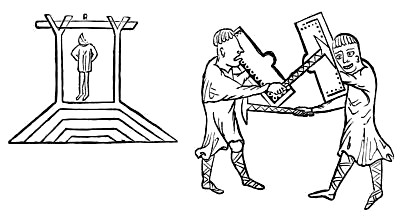
In the very curious instance of the seal of Thomas Furnival, his arms are shown in a lozenge-shaped shield. This is of date 1274-9, and is engraved in Herald and Genealogist, vol. iii, p. 334. Even at this early date such a shape seems to have been usually reserved for ladies. Sir George Mackenzie [quoted in Guillim's Display, ed. 1724] mentions that Muriell, Countess of Stratherne, bore her arms in a lozenge in 1284.
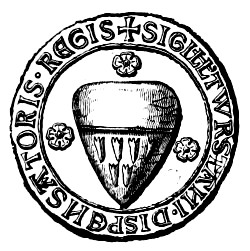
Another very curious shield of Helie Count de Maine is reproduced in Montfauçon's Monarchie Française. This is a wedge-shaped or triangular shield, but the top has square corners and is peaked (see No. 48). The seal of Turstan Dispensator Regis, about 1210, shows the heater-pear with the upper corners slightly varied. This is engraved in Collect. Top. et Gen., vol. iv, p. 239. The ancient arms of Despencer are said to have been Ermine, a chief Gules; but this seems to represent ... six cloves, four and two, and a chief; and to fill up[21] the space three cinquefoils are introduced in the field.
But, as before laid down, the general shapes of shields in this century are the Norman No. 2, often of very long proportions, as shown in William de Longespee, Earl of Sarum, 1226, and the statues at Wells Cathedral, 1230; the heater-pear No. 6, and the plain heater No. 5, rather long and pointed. A Clifford seal given in Nicholas Upton, p. 91, of date 1220, has a heater-pear shield on the seal, and an ordinary heater on the smaller counterseal (see No. 49). We may remark that on the tomb of Queen Eleanor, in Westminster Abbey, appears, on a long-shaped heater shield, the first example of quartering in England which just comes within the limits of the thirteenth century. This represents the two kingdoms of Castile and Leon, but it was undoubtedly the example which afterwards led to regular quarterings of arms by families.
It is noticeable that during the latter half of this century shields begin to be shown in seals, suspended by the guige, which is passed round a tree or other device from which it can hang.
Flowers, leaves, and even architectural details, enarching, &c., now begin to appear, to fill up the field, and the whole tone approaches the style prevailing in the following century.
It may be as well to remark in this place that milled, dotted, or roped lines around seals are no indication of date. They appear in all these varieties as early as William the Conqueror, and extend to the latest times, according to the fancy of the artist.
Inscriptions are in longobardic, with plain Latin capitals often alternated; and in the seal of Henry II. the letter R has a line across the tail, signifying a contraction—HENR for Henrici.
Until the end of this century a cross is used at the[22] beginning of the inscriptions, but about 1275 stars appear, and in the next century trefoils and other devices are frequently introduced instead of crosses.
FOURTEENTH CENTURY.
This century opens with that most valuable fund of information the celebrated Baron's letter, 1301, the seals attached to which are beautifully engraved in the Monumenta Vetusta of the Society of Antiquaries, vol. i, plates 28-33. A large number of these show heater shields, some more and some less pointed. The beautiful round seal of Simon de Montacute shows a square shield, No. 7, with a pointed French base; while to represent the curving of the shield the top is concave. The side spaces in the field, as is frequently the case with seals of this date, are filled up with two grotesque animals or worms, while in the place where a crest would be appears a large castle, &c. The counterseal to this is square, representing a griffin segreant, not in a shield at all, but surrounded by a bordure.
Badges or portions of armorial bearings obtained from heiresses now frequently appear on the fields, to fill up; being the way in which such intermarriages were shown before the general introduction of quarterings. Flowers in the field, also enarching and architectural details, are freely used to fill up the blank spaces, and in one of the seals attached to the Baron's letter—that of Hugo Bardolf, of Wormgay (see No. 50)—no room is left outside the architectural embellishment for an inscription. Seals also occur shaped entirely like a heater shield; with a similar shield in the centre containing the arms, as in that of Matthew Fitz John, where the three lions rampant appear, while the space beyond is filled up with the inscribed name of the owner. See No. 51.
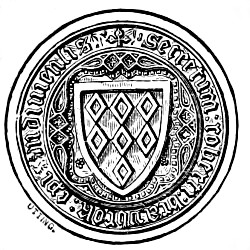
The seals of this whole century are most beautifully designed and executed, and almost universally show the heater shape; pointed in the earlier decades, and becoming gradually shorter and more square-shaped say about 1370. The secretum of Robert Braybroke, Bishop of London 1382-1401, well shows this squareness. It is engraved in the Proceedings of the Society of Antiquaries, 9th Dec, 1869, also 3rd Feb., 1887. To the same deed, dated 21st May, 1392, is also attached the seal of Sir Gerard Braibrok the younger.
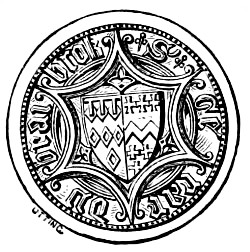
The fields are beautifully decorated, being diapered or filled up with architectural or ornamental details—lines, dots, and flowers; while frequently crests, with helmets and mantlings, occur; and sometimes two of such helmets are placed as supporters on each side of the shield, or two grotesque animals hold up the helmet and crest, while the shield of arms appears in the base.
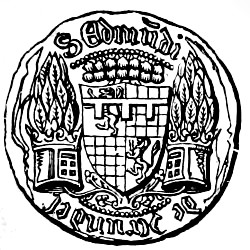
Gothic lettering in the Latin inscriptions now first appears, although more frequently longobardic, and occasionally still the plain Roman capitals. Frequently the whole face of the seal is so filled up that the only spaces left for the inscription are on the edges, above and below the arms. The seal of Edmund of Arundel, 1301-26, shows this arrangement. It is from[24] Herald and Genealogist, vol. ii, p. 56. Now, also, two, three, or more shields appear, conjointed or standing side by side. The earliest instance I have noticed is Sigillum Ide de Clinton, 1298-1300, with three heater shields, points to the centre [Nicholas Upton, p. 82]. Towards the middle of the century they are frequently found.

In the curious seal of Rich., fil. Ricardi de Beyvill of Wodewalton, which is heater-shaped, and attached to a deed 1349, a square heater shield shows a chevron between three roundels, and is supported by two worms or dragons, while across the top of the seal appears the name "Beyvil." This is engraved Visit. Huntingdon, p. 116.
Besides the curved heater of the last century, which appears in the great seal of Edward II., 1307, and in several monumental effigies, others of Norman heater form No. 2 appear with the upper corners cut off and sometimes rounded. Refer to an effigy in Norton Church, Durham, engraved in Surtees History, vol. iii, p. 155 (see No. 52), while in illuminated MSS. shields occur with the bouche deeply cut and the base of the shield curved outwards. This curved outward turning will be discussed while speaking of similar shields found in the next century. Two which occur in Bamberg Cathedral are engraved Archæological Journal, vol. ii, p. 217, and in Hewitt's Armour, vol. ii, pp. 138-9, and are specially curious (see No. 55); and several are shown from Harl. MS. 14379, and engraved in Cutts, p. 434.
Shields on monumental effigies almost, if not entirely, disappear in the course of this century, and in battles and tournaments in ancient MSS. of this date the knights are more usually represented [25]without shields. Such is the fact; the reason being that defensive armour had been added to and improved, and increased in respect of weight, as experiences of war showed the contingencies against which it was desirable to be protected. The shield, therefore, became an encumbrance to the mounted knight, while so perfect was his case of steel, and so admirably fitted and designed, that the shield was no longer required. We notice that this general discarding of shields by mounted knights begins about the latter half of this fourteenth century among the wealthy and powerful, who could procure expensive and perfect suits of mail. It is in memory of such only that costly monumental effigies were erected, and, as a consequence, the shields formerly shown carved by the side of the knights now entirely disappear from effigies. The reasons here put forward are quite borne out by other evidences. Monumental brasses, which now lend their assistance to our search, were far less costly memorials than such effigies. Some of the earliest of these represent the dead knight as he appeared in his life, with, his shield upon the arm; but in the course of the following fifteenth century these, too, follow the fashion we find prevailing in MS. illustrations, and the shields are only used for the purposes of heraldry, and are relegated into the corners of the brass, or up among its tabernacle work.
While on this subject of suits of mail, I may with advantage overstep the limits of this century—as, indeed, I have already done—and mention that such went on increasing so greatly in protective perfectness, and, pari passu, in their oppressive weight, that a knight falling off the horse upon which he had been placed lay perfectly helpless; and history records many times that they were slain by clowns and boys while lying helpless on[26] the ground. When the style of protective armour became so exaggerated, a man so hampered could do little more than hold his spear and guide his horse. Until at last, about the year 1602, King James I. summed up the past experience of armour thus:—"It was an admirable invention, which preserved a man from being injured,—and made him incapable of injuring any one else."
In some books it is stated that the introduction and gradually increasing use of gunpowder in war led by degrees to the abandonment of shields; but the above evidences completely refute such an idea. Heavy mail armour, exaggerated into an absurdity—as pointed out by King James—did so disappear when it became evident that such afforded no protection whatever against a small bit of well-directed lead. But shields had already been abandoned by the knights,—long before, at a period when gunpowder was as yet a great and rare mystery.
Besides, we find round shields were still in continued use by the foot-soldiery, when every battlefield was contested with fire and sword—the smoke as well as the din of battle.

Moreover, examples have come down to us of such shields with fixed pistols projecting through, and with a peep-hole for sighting. Thus shields were made the handmaid of gunpowder; and, as a matter of fact, they were in use by foot soldiers so late as the middle of the seventeenth century.
We noticed that the heater shields which obtained so largely during this century, and grew less and less pointed as it progressed, at last became much squarer. The seal of Edmund Mortimer, Earl of March, 1372, might well be taken for the fifteenth[27] century; the square heater, with blunt-shaped base; the inscription in Gothic, and curiously placed at the top and bottom; and the two supporting helmets, with mantlings and huge panaches, out of which appear below the hinder half of the bodies and legs of two animals, the rest of their carcasses being crammed inside these helmets. This is taken from the engraving in Herald and Genealogist, vol. ii, p. 56.

But from about this date downwards we can perceive much more discriminating taste exercised in designing seals. The seal of Richard Earl of Arundel, 1330-76, from the engraving in Herald and Genealogist, vol. ii, p. 54, is an example of such beautiful design and execution.[3]
The small seal of Matilde Fraunceys, relict of Simon Fraunceys, citizen of London, attached to a deed 33 Edward III. [1359], is a characteristic example of ordinary small well-executed seals prevailing in this century. The engraving is from the Proceedings of Society of Antiquaries, 11th Dec., 1856.

Some families seem to have taken a special pride in their seals. Those of the Bardolfe family of Wyrmegeye, Norfolk, continue pre-eminent for several generations. Occasionally one member of a family shows a seal of extreme beauty, the work of some "Strongitharm" or "Wyon" of those days, and in this way the centuries may frequently seem to overlap each other. Such exceptional seals show an execution, shape of shield frequently, and[29] design somewhat later than their art-date, in the sequence we are endeavouring to lay down. Other such overlappings occur from the great age of the seal user. Elianor Ferre uses on a deed, 1348, a dimidiated seal, which was surely made about 1290. She died, a very old lady, in 1349. This seal is engraved in Archæological Journal, vol. xi, p. 375; and if you will refer to Herald and Genealogist, vol. i, p. 485, you will see a seal of Clare and Fitzgerald dimidiated on a shield of apparently identical date. The inscription is "Sigill-Elianore-Ferre"; so she used her own seal made in early life, perhaps dating from her marriage. The seal of Isabella de Fortibus, Countess of Albemarle, used in 1292, is another dimidiated heraldic seal, almost identical. See No. 53.

Pointed heater shields with concave tops, suggesting their curved shape, are not uncommon in this century, and inscriptions in Gothic type became much more frequent.
The description of a shield which used to hang, before the Great Fire, in old St. Paul's, London, will be an interesting illustration of how shields were made in the fourteenth century. This was the shield of John of Gaunt (or Ghent, as it was originally spelled), our Duke of Lancaster, the third brother of Edward the Black Prince, and father of Henry IV. He was born 1340, and died 1399, so we may assign 1370 as about the date of its manufacture. In shape it is an oblong square with rounded corners and hollowed-out sides and base, while a very deep bouche is cleft into the dexter chief. It much resembles the "Gothic-rounded No. 12," but the base is flat and hollowed out. I am quoting from Bolton's Elements of Armories, 1610, p. 69:—"It is very convex toward[30] the bearer, whether by warping through age, or as made of purpose. It hath in dimensions more than three-quarters of a yeard of length and above halfe a yeard in breadth: next to the body is a canvas glew'd to a boord, upon that thin board are broad thin axicles, slices or plates of horne nail'd fast, and againe over them 20 and sixe peeces of the like all meeting or centring about a round plate of the same in the navell of the shield, and over all a leather clozed fast to them with glew or other holding stuffe,—upon which his armorie was painted, but now they with the leather itself have very lately and very lewdly bin utterly spoil'd." This is engraved in Bolton's Elements, in Willement's Regal Heraldry, in Randle Holme's Academy, and in several other heraldic works. There is also engraved in Bolton's Elements, p. 67, the shield of Edward the Black Prince hanging over his tomb at Canterbury. This was of the egg shape No. 35; and in a circle in the centre were, on a heater shield No. 5, the arms of France and England quarterly with a label of three points; while around this circle the rest of the shield was embossed or "tooled" with an elaborate filagree pattern, and a narrow plain rim extended round the outer edge.
The inscriptions in this century continue to be in Latin and in Roman letters, but sometimes Gothic lettering is used.
FIFTEENTH CENTURY.
Our materials for proof during this century are peculiarly numerous and rich. There is great store of beautiful seals, many of them highly decorated, and preparing us for their decay and disappearance after about 1490. Then again, MS. illustrations of tournaments show the shaped shields of the knights hung up on tents or elsewhere,[31] and adorned with their heraldry; and occasionally, and in one case as late as 1480, two knights appear on horseback, jousting and bearing shields; also, in some cases, combats on foot, where the knights carry shields. We have also stained glass with shields, which, at this early time, seem more closely to follow the shapes of those actually in use.
Grants of arms now begin to supply shapes of shields, and towards the end of the century printers' marks appear, although these last seem to be affected by a fanciful exaggeration.

Add. MS. 15,477—date 1360.
As a case of recrudescence of old ideas we must refer to the instance of a bouche, in which to rest the spear, so early as 1360, in Add. MS. 15,477, in the British Museum (Hewitt, vol. ii, p. 231); indeed one is represented vastly earlier, in 1159, in the seal of Theodoric Count of Flanders, engraved in Oliver Vredius, p. 17 (see No. 46). Such shields are now very frequent, except upon seals, where[32] they seldom occur; and the reason is, no doubt, that they would have interfered with the heraldic charges, which now begin to be multiplied.
Heater shields, and sometimes pointed, just as they appear at earlier dates, are still continued; but in most cases, and especially towards the middle and end of the century, they become much more square and blunter at the base.
Seals of the more important families are filled up with elaborate decorations—diapering on the fields, leaves and mantlings filling up the whole space, and supporting animals, finely and boldly designed, are introduced; and several concentric lines, differently ornamented, with quatrefoils, crosses, mullets, and stars upon these circular bands sometimes occur within the inscription.

From about 1420 a custom began, and is occasionally adopted in the larger seals, to represent as scrolls those bands upon which the inscriptions of name and title, &c., were written, while the ends were ornamentally unfolded and loose. To show exactly what I mean I would refer to the seal of John de Clinton de Say, 1438, No. 54, engraved in Archæologia, vol. xxxviii, p. 272, and to that of Sir John Pelham, 1469. This is engraved in Archæological Journal, vol. vii, p. 323; the Sussex Archæological Society's vol. iii, p. 220; also in Historical and Genealogical Notices of the Pelham Family, privately printed in 1873 by the late Mr. M. A. Lower.
Many of these seals are marvels of design and[33] execution. At the very end of the century we notice so much is sought to be represented that the designs in consequence become flat and weak, losing much of their character and boldness, and thus preparing us for the startling change in the following century. Another noticeable circumstance is that such splendid and pretentious seals are not confined to the greatest nobility or people of vast territorial influence. Many untitled families towards the end of the fifteenth century showed seals not quite so large, but fully equal in workmanship and beautiful design to those of the house of Lancaster, the Nevilles, Lords of Abergavenny; the Dukes of Buckingham, and other great titled nobles. Through the kindness of Mr. H. S. Grazebrook I am able to show the seal of Richard Dudley of Clapton, Northants; the arms of Dudley quartering Hotot [see William Salt Society vol. x, p. 54]. This seal was exhibited to the Heralds at their Visitation of Northants, 1618, "antiquum Sigillum argenteum," and is tricked in their original MS. As its date is between 1440 and 1475, I have no doubt it was made for that Richard Dudley of Clapton who "condidit testamentum" 1465.

We must now take up those curiously curved outward shields, alluded to as shown in Harl. MS. 4379, of a date about 1360, see No. 55, and again at Bamberg Cathedral, 1370 [page 24], see No. 55A and No. 55B. We may lay it down as an axiom that every alteration in the shapes of shields at these early dates, and therefore for actual use, arose from some apparent advantage to[34] be gained by it. Hewitt, vol. ii, p. 314, engraves a curved shield, about the end of the fourteenth century, from an ivory chessman. In the Archæological Journal, vol. ix, p. 119, there is one, from stained glass, of early in the fifteenth century. This is a square parallelogram with a bouche, and the top and bottom are projected forwards, while the intermediate portion is flat. This shield is of considerable thickness, see No. 56. In the statue of Henry VI. at Westminster, of the date 1422, a similar shield appears without any bouche, but with the top and bottom ends similarly projected and the middle portion flat, see No. 57. This is engraved in Meyrick's Ancient Armour, plate 42. A similar shield, from an ancient chest in York Minster, is shown in the same book, vol. ii, at p. 124. In the grant of arms to the Ironmongers' Company, 1455, and in many other instances, a bouched shield, deeply engrailed at top and bottom, has both ends similarly projected, the middle portion being curved, but to a lesser degree. This is engraved in Herald and Genealogist, vol. i, p. 37, and the same shield of arms is illuminated in the margin of the charter granted to the Ironmongers in 1483. It seems evident that the intention in thus hollowing out the face of the shield was to receive and to retain the spear point with greater certainty upon that part of the shield; as in combat it was found to slip off above or below, and search out for itself some dangerous resting place on the helmet or other vulnerable part of the armour. This shape could not readily be shown in front view on seals, but such shields curved outwards appear frequently with great clearness in illuminations where a side view is commonly given, see an engraving of men at arms in fourteenth century in Cutts, p. 339. I am also able to show a most interesting illumination of a knight of the fifteenth[35] century bearing a very curious shield. This is from Cutts, p. 398.
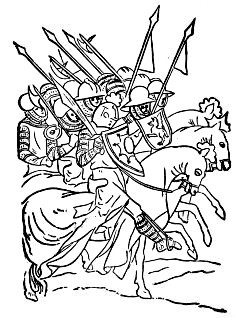 |
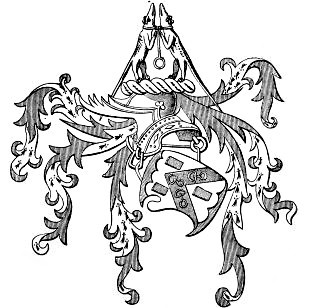 |
| Date 14th century. Cutts, p. 339. | Grant of Arms to the Ironmongers' Company, 1st September, 1455. From Herald and Genealogist, vol. i, p. 37. |
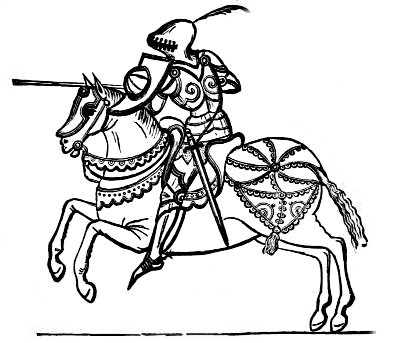
Round shields borne by foot soldiers appear curved and bulged out in the same way. I annex the representation of a soldier with a spear and such a round shield from Cotton MS. Claudius, D. ii, fol. 30. This dates from the earlier part of the fourteenth century, and is engraved in Hewitt, vol. ii, p. 114. This formation is apparently meant to give strength, and to ensure a cut or thrust gliding off, rather than resting upon the shield.
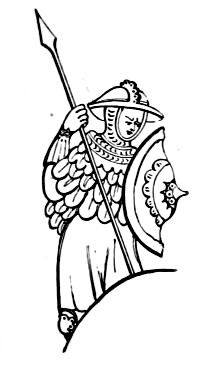
The reasons for some other alterations are not so apparent; for instance, in the seal of Ralph Shelton, circa 1460, see No. 58, a curious projecting point is shown in the right hand base [called sinister in heraldry] of the shield, and a similar projection[37] occurs in the beautiful escutcheon of Elizabeth of York, wife of Henry VII., 1485, see No. 59, engraved in Willement's Regal Heraldry. A stone carving of a bouche, with a very similar formation and of the same date, and bearing the Tilney arms, is found upon Shelly Hall, Suffolk, and is etched in the Anastatic Drawing Society's volume for 1871. It seems probable this was originally meant to protect some part of the left leg or ankle which was liable to be injured in combat. Another shield here shown gives with great clearness this curious point. It is engraved in Mr. Cutts' book, p. 402, and taken from Harl. MS. 4925, fo. cxxx. This, however, is too small to protect the leg.

Many shields now occur with hollowed-out sides, and engrailed at the top and base, and are classed in our plate under the various forms of Gothic (Nos. 9 to 12). Sometimes the top is straight, while the sides and base are engrailed out, and in instances, perhaps under German influence, the bases are rounded. The endless variety of these beautiful Gothic shields is most fascinating. The wonder is that they lasted for so very short a time, from the middle of this fifteenth century to the first few decades of the sixteenth.
In Cutts' valuable book, p. 454 (see No. 59), two unmounted knights, from an engraving by Hans Burgmaier, are represented in combat, about 1450, carrying two very curious shields, somewhat similar[38] in idea to these Gothic shields. Being divided lengthways into three partitions; both are broader at the top and narrowed at the lower end, and they seem to be about 3 feet 6 inches long. One is convex at the top and engrailed, with a bluntly-pointed base; the other is flat but slightly engrailed, and the rounded base somewhat broken by the three divisions, which evidently suggest that these shields were curved round the body. But the old plain heater continues as by far the most prevalent shape throughout this century. It is usually very square, and in several instances there is an approach to the French base of Mr. Rylands' nomenclature.
As already remarked, foot soldiers of all ages, down to the middle of the eighteenth century, appear with round shields. During this century and the next these are shown with handsome decorations, but never with heraldry on the face: foot soldiers, perhaps, were not considered heraldically armigerous. In an Italian painting of this century, foot soldiers are represented with square and diamond shaped shields, each side shaped out in curves; and in one heraldry is painted; perhaps he was a dismounted knight and the others only retainers. This may be seen engraved in Jacquemart's History of Furniture, p. 24 (see No. 60).
In many other shields at the end of this century the heater shape has gradually arrived at what is named square No. 7, and in the charter granted to the waxchandlers, 1484 (see No. 61), and in many other instances, these shields were very long in proportion to their width. The same elongated shape appears in a shield on Christ Church gate, Canterbury, date 1517; engraved Archæologia, vol. xvi, p. 194.
Mantlings.
The first observed instance of a mantling or lambrequin, as it was then called,—a term still applied to it by the modern French heralds,—occurs in the large seal of Ralph de Monthermer, Earl of Gloucester and Hertford, 1299. This is engraved in Nicholas Upton, De Usu Militari [Bisse edition, 1654, p. 63]. In Planché's Poursuivant the helmet and mantling alone are engraved from this seal. It is represented as a square handkerchief or shawl fastened at one end under the crest, and flying out loose behind. There is no hacking (see No. 62). Ralph de Monthermer was a "plain esquire," but attracted the attention and secured the love of Joan of Acres, daughter of Edward I. and relict of Gilbert de Clare, Earl of Gloucester. May we be allowed to fancy we see here the kerchief of the fair lady whose favour led to his advancement, and whose marriage eventually brought him his title? His second wife was also a widow, namely, the relict of John de Hastings and sister of Aymer de Valence, Earl of Pembroke.

In Planché's Poursuivant is engraved another very similar, from the seal of Thomas, Earl of Lancaster (see No. 63). He was beheaded by Edward II. (1321). This seems to be of some thick material and bordered. It is better shown in the full-sized engraving in Sandford's Genealogical History, p. 102. Boutell (Heraldry, p. 212) describes No. 64 as a "contoise," and says it was used until the middle of the fourteenth century. These seem to have been stiff to stand out, but I have not found representations of any more of them. Mr. Boutell refers to two effigies showing them in Exeter Cathedral, and another in Westminster Abbey. In the seal of John de Tilneye to a deed, 1353 [engraved in the Visit. Hunts., p. 29], a voluminous[40] and square folded mantling, without any hacks, is extended out to the inscription on each side, and is fixed under a broad-brimmed hat which stands on the top of the helm, and on this hat is the crest, viz., a tree supported by two lions gambs. There is another instance on the monument at Norton Brize, Oxfordshire, to John Daubygné, 1346, where the mantling is extended out square in folds, without any hacking, and hangs on each side of the helmet, while below is placed the shield. This is engraved in Boutell's Heraldry, p. 156 (see No. 65). Another such squarely-folded and unhacked mantle is shown on the seal of Elizabeth de Lucy, 1354, with a man's helmet and crest (!!)—see No. 66—and yet another in that of Sir William de Lucy, 1392. Both of these are engraved in Nicholas Upton, p. 73 (see No. 67). But these must all be taken as rare exceptions. Usually mantlings of so early a date as the fourteenth century are of very small dimensions, hacked and lying close on their helmets, clinging to them, as it were, and so fastened under the crest that they could not hang otherwise. As we see in the seal of Richard, Earl of Arundel, about 1350-70 (illustrated at p. 27), also in the seals of Sir Thomas Bysshe, 1381 [Nicholas Upton, p. 53], see No. 68; and in that of John de Clinton, 1386 [Nicholas Upton, p. 82], see No. 69; but seals of the fourteenth century more commonly show no mantlings: they were only just beginning to be introduced.

At the beginning of the fifteenth century the same small hacked mantlings, hanging closely upon their helmets, still continue, and become the rule; it was the exception to have any mantling at all in[41] the fourteenth. About 1420, however, they begin to spread over the field of the seal, in free and bold curves and waves. In the seal of John, Lord Clinton de Say, 1438 (No. 54), and in that of Humphrey, Earl of Stafford and Perche, 1438, both engraved Archæologia, vol. xxxviii, p. 272, they are seen hacked, wandering away from the helm, and half way down the shield. But a noteworthy characteristic of the mantlings of this early date, and one to which I must draw your particular attention, is that, although stretching their arms boldly about the field, and in MSS. where space will allow, they may extend down below the base of the shield, they are not, perhaps never, seen to hide themselves behind it! The spirit of those old times when the mantling would probably be the gift of some fair lady, perhaps her kerchief or mantle, and borne with chivalrous fervour through the many adventures in which the knight of those days sought to gain fame and experience—this spirit of honouring the mantlet still remained burning brightly; a fold was therefore too precious to be hidden behind the shield. When we come to consider such decorations in later times, when such sentiment had departed, you will see why [beyond the valuable indication of date supplied] I have drawn your attention particularly to this peculiarity to be noted in the fifteenth century. The seal of Thomas Strange, 1419, shows a curious arrangement of mantling. This is engraved in Miscell. Genealogica et Heraldica, 1884, p. 59. In the very curious and interesting seal of Sir John Pelham, 1469, engraved in Archæological Journal, vol. vii, p. 323, and already illustrated on p. 32, the field of[42] the seal is filled up with bold contortions of the hacked mantling, while on the helmet appears the most extraordinary crest—a large birdcage which is higher than the helmet itself; it is divided into three tiers of wickerwork, and has a pointed roof, while on the field appear two buckles. Sir John Pelham, at Poictiers in 1356, personally assisted at the capture of the French King, when the honorary distinction of the buckle as a family badge was accorded to him. His descendants sometimes used the birdcage crest, in remembrance of the same exploit and the imprisoned king.
In illuminations of this date, say of the latter half of the fifteenth century, we see the same characters—the mantlings so divided into narrow ribbon-like folds, much hacked and twisted to show the lining, and thrown out into bold arms around the shield and extending some way below it with fine artistic effect. I would refer to the grant of arms to the Fellowship of Ironmongers of London, 1st September, 1455, already illustrated on p. 35, also to the shield of Edward IV., 1460, in Willement's Regal Heraldry. There are also two beautiful specimens engraved in Boutell's Brasses; one, the stall plate at Windsor of Sir Humphrey Stafford, K.G., 1460, at p. 219 (see No. 70), and at p. 207 the brass of Sir William Say, at Broxbourne, Herts, 1473 (see No. 71): the mantling in the last ends in four tassels; this addition of tassels becomes the ordinary usage in the MS. illuminations and in grants of arms, but not in seals of the sixteenth century.
I refer to No. 72 for the lithograph of that very curious mantling carved in stone at Wyverton, Nottinghamshire (Thoroton's History, p. 98), which displays three tassels. This stands with two other helmets, each over its respective shield of heraldry, and on examination I am able to declare their date to be about 1440-50.
Licence of free warren and to make a park here was granted 24 Henry VI. (1445), at which time Thoroton supposes this house was built.
Following our entirely different lines of enquiry, I am able to state, to within twenty or thirty years, the date of these carvings; and I would further say that as to one of the quarterings displayed, the Chaworth family did not inherit the right to bear it until 1422; thus confirming very exactly Thoroton's date.
Perhaps the first appearance of a tassel on a mantling is on a monument to — Harsyck in Southacre Church, Norfolk, 1384; engraved in Boutell's Heraldry, plate I (see No. 73). This is also interesting as being a very early example of the wreath or torse which supports the crest, consisting of a twisted cord of silk of two colours. In a brass to Sir Hugh Hastings, at Elsing, co. Norfolk, 1347, the same is shown. In the effigy of Sir Richard Pembruge, 1375, now in the nave of Hereford Cathedral, the crest and helmet are attached with a wreath of leaves, above which rises a great panache of feathers.
The earliest instance of a date upon the face of a shield is said to occur about the middle of the thirteenth century, but such are very uncommon until the sixteenth century, when they are found both on personal and official seals.
The inscriptions on English seals of this fifteenth century are almost universally in Latin and in Gothic lettering. I have, so far, only noted one seal with Roman letters, and that occurs in 1403.
SIXTEENTH AND FOLLOWING CENTURIES.
Before entering upon our subject during this period, it is necessary to consider the great changes, social and legal, which passed over England from say 1450 to the end of the reign of Henry VIII.
Events for thirty years before the accession of[44] Henry VII. (1485) had been gradually reducing the power of the nobility. Enactments had been passed which facilitated the transfer of lands; and the disastrous wars of the Roses, in which the blood of the nobility flowed like water, brought also the dispersion of a large portion of their estates, and the consequence was that when Henry VII. began his reign, and the conflicts between the rival Houses of York and Lancaster were completely hushed [say 1485], he found himself in possession of the sole power. The great nobles who had hampered the actions of his predecessors had disappeared from the scene. At his first Parliament Henry VII. only summoned twenty-eight peers; and so gradually did this class recover itself that we find at the first Parliament of Henry VIII. only thirty-eight peers were summoned to attend.
We can thus understand how those seals of exceeding size and magnificence, which we found prevailing during the middle and third quarter of the fifteenth century, entirely disappear. The greater nobility, as an assertion of their dignity and importance, had then attached to their charters seals of great pretensions, and gradually increasing in size until, as Sandford [Genealogical History, p. 108] remarks of those of the Dukes of Lancaster, they rivalled or even exceeded in size what were used by the crown itself. Had their embarrassed affairs allowed them to enter again into mutual rivalry, the stern government of Henry VII. would have regarded such an assumption of dignity as treason to the throne, and therefore we can fix the date 1485 for the disappearance of such large and splendid seals. Only occasionally do they continue to appear, and within the limit of ten years after this time.
The landed gentry, the descendants in many instances of a much earlier feudal aristocracy, had suffered almost as much from the rivalries and[45] conflicts which had devastated the country. They, too, laboured under the same depression and necessity for retirement; and hence, if we take up a bundle of deeds, say of the third quarter of the fifteenth century, we shall find them loaded with large and beautiful seals, while in a similar parcel, dated early in the sixteenth, small bits of wax only are found, many of them bearing one or more initials, or a crest surrounded by a circle of large dots, and the coats of arms, which do occur, are altogether small and insignificant: in fact, personal seals are now reduced in size to what may be conveniently hung on a watch chain, or worn as a somewhat large signet ring. I annex some heraldic seals just to show what after this time are looked upon as unusually fine. They are a very great contrast to those we have been considering.
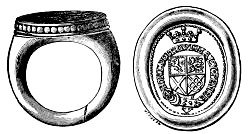 |
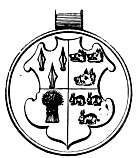 |
| Ivory Thumb-ring Signet of Francis, 5th Earl of Shrewsbury, 1545. [Proceedings of Society of Antiquaries, 22nd December, 1859.] | Robert Ap Rece, 1548. Engraved in Visit. of Hunts, 1613 [Camden Soc.], p. 32. |
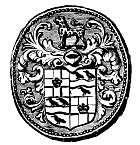 |
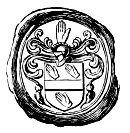 |
| Seal engraved by Thomas Simon for Sir Edward Nicholas, Secretary to Charles I., circa 1649. [Collect. Gen. et Topog., vol. viii, p. 214.] | Thomas Bate, of Ashby-de-la-Zouche; born 1648, died 1707. |
But still further reasons have to be considered. The ancient form of drawing charters was gradually disappearing, which after declaring the transaction, ended with the all-important seal, put on in the presence of such responsible witnesses as could be got together, and who were afterwards always to be found to come forward and vouch for the transaction. Writing also now, early in the sixteenth century, was becoming much more common, and the sense of the nation showed that a deed signed and sealed by the parties was much more satisfactory than any number of witnesses, the limit of whose testimony was bounded by that of their lives. I am only putting into few words what is ably pointed out by Williams in his work on Real Property, ed. 1882, p. 153, and by Blackstone in his Commentaries, ed. 1823, book ii, p. 305. But the curious thing is that this change seems to have gradually taken place without any enactment directing it. The Statute of Frauds and Perjuries, 29 Charles II. (1677-8, cap. 5), is the first instance where it is expressly declared by act of Parliament that all devises of lands or tenements must be in writing and signed by the party and three or four credible witnesses. Such had already been occasionally the practice for at least two hundred years, for I find a deed of gift of Thomas Hoo to the Abbot of the Monastery of Battle is thus established "Sigillum meum, una cum subscriptione propria manu et signo manuali apposito"; the date is 21st September, 1480 [Thorpe's Battle Abbey Deeds, 1835, p. 124]. Occasional instances occur of the old system of sealing only before a number of witnesses, but after say 1520 the almost universal method of executing deeds was by sign manual and seal, and two or three attesting witnesses.
The earliest instance I have noticed of executing a deed by sign manual is as above, in 1480. The[47] latest which I have met with, in which the ancient form of execution had been followed, is a charter printed in the Salop Archæological Society's vol. x, p. 222:—"Thomas Scriven, armig., grants a yearly payment of 8/ sterling out of his meadow at Coleham, juta sive prope Ville Salop, hiis testibus &c. &c., dat. Salop 25th Sept., 10 Henry VIII., 1518"; but probably yet later instances may be found.
The further reason, lying at the root of the whole matter, was the wonderful expansion of trade, wealth, and intelligence which broke upon England at this time,—the English renaissance, as it is called, and which culminated in the brilliant company of poets and authors of Elizabeth's reign. Following upon the breaking-up of the old nobility, and the resumption of peace at home, wealth was rapidly accumulated by many self-made men, and by many younger sons of old families, who entered into trade. These purchased lands and became the county gentry. So expansive was this spirit of trade, that ancient towns like York, Chester, Lancaster, Coventry, and Lincoln, where long-established guilds restricted trading to the burghers alone, fell off in population and importance, while new districts without such restrictions, such as Manchester and Birmingham, as rapidly increased. In an act, 33 Henry VIII., c. 15 [1541], it is stated that the people of Manchester were then "well set to work in making of cloths, as well of linen as of woollen, whereby the inhabitants of the said town have gotten and come into riches and wealthy livings: and by reason of great occupying, good order, strict and true dealing of the inhabitants of the said town, many strangers, as well of Ireland as of other places, had resorted thither."
Over all this boiling-up of busy-ness sat Henry VII. and Henry VIII., as almost irresponsible sovereigns,[48] and out of it grew the Commons of England! The population meantime increased with wonderful strides. In 1377 the population of England and Wales did not exceed 2,500,000. By the military musters, taken 1574-5, there were 1,172,674 of able men for service, which it is estimated would give a total population of about 4,700,000. This astonishing revolution of trade and learning is so remarkable that I must quote a portion of what old Harrison says on the changes he had noticed within fifty years. His most curious Description of Britain was printed with Hollingshed's Chronicle in 1586, but was probably written some ten years earlier: an exacter date I have not yet been able to fix. "There are old men yet dwelling in the village where I remaine which have noted three things to be marvellouslie altered in England within their sound remembrance: and other three things too, too much increased. One is the multitude of chimnies latelie erected, whereas in their young daies there were not abouve two or three, if so many, in most uplandish townes of the realme [the religious houses and manor places of their lords alwaies excepted, and peradventure some great personages], but eche one made his fire against a reredosse in the haull where he lived and dressed his meat; secondly, the bedding [now feathers and comfort, &c., then straw or wood only, &c.]; thirdly, the exchange of vessells as of treene platters into pewter, and wooden spoones into silver or tin. So common were all sorts of treene stuff in old time, that a man should hardlie find four pieces of pewter [of which one was peradventure a salt] in a good farmer's house, &c., &c., &c. Whereas, in my time, altho' peradventure £4 of old rent be improved to £40, £50 or £100, yet will the farmer, as another palm or date tree, think his gaines verie small [49]toward the end of his term if he have not six or seven years' rent lieng by him, therewith to purchase a new lease, besides a faire garnish of pewter on his cupbord, with so much more in od vessell going about the house, three or four feather bedds, so many coverlids and carpets of tapistrie, a silver salt, a bowle for wine [if not an whole neast], and a dozzen of spoones to furnish up the sute."
But, alas, there is another side to all this national prosperity. From this time, also, agriculturists—required in fewer numbers under the new styles of cultivation (which aimed at grazing and the production of wool)—crowded into the towns in hope of work, and large portions of the population began to sink into the lowest depths of poverty.
In our researches as to the shapes of shields we have now, therefore, lost that rich body of evidence supplied by the seals on charters, which extended to nearly the end of the fifteenth century, and the MS. pictures of knights and tournaments. The evidences now available consist of pedigrees, the smaller heraldic seals attached to documents and deeds, heraldic visitations and grants of arms, printed books on heraldry, which begin 1496, stained glass, the stone carvings on buildings, tombs, and ledger stones, and, from the end of the seventeenth century or a little earlier, book-plates. Coins, too, now prove of some value to us, showing what were prevailing types of shields.
But inasmuch as there were no shields actually in use, the shapes prevailing now became entirely a matter of fashion and taste. Randle Holme prints sixty-five varieties of shields, and remarks (p. 10 in his Academy of Armoury, Chester, 1688):—"But [as to the former shield] so to this, a question may be made, whether such an one was used by him, or only the invention[50] of the cutter? If so, then the shapes and forms of shields, targets, and bucklers would be as many as carvers, stone cutters, engravers, and painters please." Gerard Legh gets the credit of having greatly multiplied, in his Accedens of Armoury, 1562, the fanciful shapes of shields; and later writers on heraldry seem to have followed him. [Herald and Genealogist, vol. i, p. 191.] But an examination of the Wappenbüch, published in Germany in the sixteenth and seventeenth centuries, and similar heraldic drawings of Italian coats, have opened out to me a vastly wider field for variety than old Randle Holme ever supposed. I have before me a copy of Virgil Solis, which was published at Nurnberg in 1555. This contains hundreds of coats, in shields of an endless variety of shapes and great boldness of design; and when we come to critically compare these shields with one another, we discover that their outlines depend upon the charges! These were first laid down with grotesque boldness, and the outline of the shield to bear them was then drawn around them, to the artist's fancy of what best suited the bearings and would most reduce the amount of empty field. This is, after all, only reversing the ancient method, where a lion was distorted to suit a pointed heater; and it is suggested that a pale, for a similar reason, might sometimes be pointed into a pile. With this revelation from Virgil Solis, we can detect that the same method of designing prevails elsewhere. We must therefore multiply Randle Holme's carvers, stone cutters, engravers, and painters by the possible variety of their fancies, and then multiply the quotient by the number of all the heraldic bearings—plus all the positions and forms they may be made to assume—if we wish to arrive at the variety of shields possible during the period we are now about to consider.
In deference to this unanswerable position, I find it necessary to alter entirely the classification pursued in the earlier centuries—to take Mr. Rylands' drawings seriatim, and to give for each shape the earliest and latest dates at which, in my limited researches, I have found them in use. This method of treatment eliminates from our enquiry all strictly fanciful shields which did not gain a hold on public taste, and leaves us still with a sufficiently heavy list of variations to which it is possible, from their frequent recurrence, to attach the dates.
A few leading remarks on points bearing on our subject will prove useful at this stage of our enquiry.
Before watches became common, seals were sometimes attached to the arms, like bracelets. In Mercurius Rusticus, No. 30 (for 19/20 July, 1660), an advertisement appears for "a gold seal, being a coat of arms, cut in a piece of gold, in the form of a lozenge, fastened to a black ribband to tye about the wrist." In the Visitation of Essex, 1634 [Harleian Society, p. 455], appears the following certificate:—"This coate is certiffied by Thomas Scott to bee by him seen on a seale some 40 years since, and to be the seale of armes of Thomas Moore Esq. father of the said Hunting Moore, and that Robert Scott his father did weare the same about his neck in a scarffe about xx yeares—in witnes whearof I have sett to my hand. Tho. Scott." [Robert Scott had married Anne, daughter of Richard Hunting and relict of Thomas Moore, of Orsett, co. Essex.] This seal was, of course, a ring.
Watches, which naturally suggest small attached seals, were, however, in pretty general use in Queen Elizabeth's reign. In Shakespeare's Twelfth Night, Malvolio says:—"I frown the while, and perchance wind up my watch, or play with some[52] rich jewel." A watch was found upon Guy Fawkes, 3 James I. (1605/6), which he and Percy had bought the day before, "to try conclusions for the long and short burning of the powder."—Stow's Chronicle, p. 878, and introduction to Mr. Reuben Burrow's Almanac for 1778.
LINES FOR TINCTURES.
The first English examples of seals with lines in the engraving, to indicate the tinctures, are said to be on some of those attached to the death warrant of Charles I., 1648-9 [Planché's Pursuivant of Arms]. Now, as this system was unquestionably first devised by Father Silvester de Petra Sancta—whose two books, L'Armorial ou la Science du Blason, 4to, and Soumaire Armorial, 4to, were both published in Paris 1638—it seems curious that within ten years we should find such conventional lines in use in England; and it follows, also, that such of these seals as were so treated in 1648 must all have been recently cut! A diagram, showing the colours so indicated, is given by Sir Edward Bysse in his edition of Nicholas Upton's work, De Usu Militari, published in 1654. The earlier works on heraldry, which I have been able to consult, have the illustrations in somewhat rough wood blocks—it would have been difficult and expensive at that time to have got finer work in wood; but we must remember that Sylvanus Morgan, in his Armilogia, published 1666, refers to Silvester de Petra Sancta's Epistles, and elaborately describes—as if they were something quite startling and new—why the several conventional lines were selected. John Gibbon, in his Introductio ad Latinam Blazoniam, published London 1682, p. 152, says, "for the distinction of colours in arms [which was devised by the Rev. Father S. de Petra Sancta]," and he (Gibbon) frames some Latin verses for the better remembering[53] thereof; but in the woodcuts which adorn his book he does not follow the system which he recommends. The earliest English book which shows them in the copper plate engravings is Bysse's edition of Nicholas Upton, published, as already noticed, in 1654. I am aware that Boutell, in his Heraldry, chap. v, says that such lining may be occasionally found before 1630. Now there seems no manner of doubt as to the inventor; and any references with dates, which Mr. Boutell could have given, would have been valuable indeed! At present we are involved in a paradox: if Father Silvester invented the idea; did he discuss it for years, perhaps before committing it to print, and having his own beautiful copper plate illustrations so drawn in 1638? I point out this interesting question. Any instance of a seal or engraving so treated with the proper lines to represent tinctures and occurring before 1638 should be carefully noted with the exact dates; and I venture to think any such solitary instance would prove to be purely accidental. The seal of Sir Edward Nicholas, secretary to Charles II., engraved for him by the celebrated Thomas Simon, does not show any tincture lines (see the woodcut at p. 45). In this seal the second and third quarters are the paternal arms of Nicholas, while in the first and fourth are displayed that honourable augmentation granted to Sir Edward in 1649. We may safely conclude that this seal was cut immediately after he received that distinction. Particulars of Sir Edward's career may be learned from Manning and Bray's History of Surrey, vol. iii, p. 40; also from Hoare's South Wiltshire, p. 88. He was Secretary to Charles I., followed Charles II. into exile, and was continued by him in his post of Secretary. He eventually returned with him, and died in 1669, at the age of seventy-seven.
I regret I have never had the opportunity to examine for myself the original death-warrant which was carried out on that chill thirtieth day of January, 1648-9; and so I am not able to say with exactness which of the seals show tincture lines, as it is said they do.
Chaplets or Wreaths.
About the end of the fifteenth century, arms are frequently found surrounded by a wreath of laurel or bay leaves, usually, at this date, divided into four parts by ribbands. Menestrier gives the date 1480 as the earliest instance he has found [his most learned works seem too little known by English heralds: the Origine des Armoiries was published in Paris 1679, and the Origine des Ornemens des Armoiries in Paris 1680]. We see an example in the tomb of Margaret, Countess of Richmond, 1509, in Westminster Abbey (engraved Sandford's Genealogical History, 1677, p. 326)—see No. 74. We find similar wreaths or garlands in Sylvanus Morgan's Sphere of Gentry, published 1661, vol. i, p. 22, and vol. ii, p. 68; and engravings of several fanciful varieties are also there given. Wreaths of olive, formed of two branches tied at the top and bottom with ribbands, appear several times surrounding coats of arms in W. Hollar's beautiful engravings in Thoroton's History of Nottinghamshire, published 1677 (see pages 199, 200, 203, 310, 486 and 487).
After a while, such wreaths were frequently introduced in the outer edge surrounding official and also personal round seals, and so arranged that they more resemble bell-shaped flowers of three leaves (like the side view of blue bells), and without any dividing ribbands. The annexed wood-cut of the Statute Merchants' seal of Carlisle, 1670, will show this. This seal was in two[55] halves to be kept in separate custody, and when used, these were screwed together into a handle to make it complete before affixing to any deed. The seal and handle are here shown from the engraving in the Proceedings of the Society of Antiquaries, 16th May, 1889. Throughout the eighteenth century, the blue bell ornament appears in corporate seals, and book-plates about 1800 are found surrounded by such oval bell-flowered wreaths.
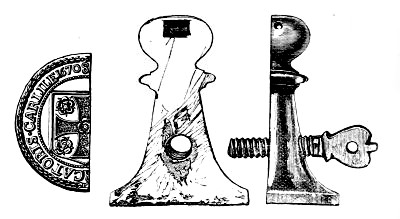
Palm Branches.
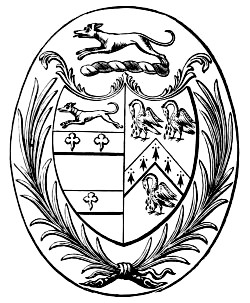
Menestrier [Origine des Ornemens, published 1680] writes:—"Now [aujourd'hui] persons of quality, particularly married ladies [femmes], place two palms together on the escutcheon of their arms, which makes an agreeable ornament, and is, at the same time, the symbol of conjugal love, which the ancients have represented by the palms, male and female." The earliest instance I have noted in England is on the cups of Sir E. B. Godfrey, who died in 1678 [engraved in Gentleman's Magazine, 1848, and in Topographer and Genealogist, vol. ii, p. 467]. They occur beneath a shield of Bridgeman, Bart. (the plain arms not impaled), in Sandford's Genealogical History, 1677, p. 228; also[56] on a monumental slab, 1671, engraved in Miscell. Genealogica et Heraldica, 1884, vol. i, p. 151. About 1765 we see two palms extensively used as decorations below Georgian shields (see the plates in Dugdale's Warwickshire, 1765; Hasted's Kent, 1778; Rudder's Gloucestershire, 1779; and Hutchin's Dorsetshire, 1774). Such are extensively seen throughout the seventeenth and eighteenth centuries, and were frequently painted, as a pleasing decoration, below the arms on carriage panels, almost to our own times. But they must have lost the original symbolism, for they occur constantly on ledger tombs [see Miscell. Genealogica et Heraldica, Mar., 1885, p. 233; dated 1696], and must then refer to the resurrection life. They are found in book-plates in the middle of the eighteenth century, and continue down to 1800 or later. The ledger tomb to Ashley Palmer and his wife at Hawstead, dated 1792, shows a pleasing example. This engraving is from Miscell. Genealogica et Heraldica, 1885, p. 307.
Supporters.
It is hard to say when we may so name the grotesque animals, which first appeared to fill up the fields in seals even earlier than the fourteenth[57] century—see that of Ralph de Monthermer, Earl of Gloucester and Hertford, 1299 [engraved, Nicholas Upton, edition 1654, p. 63], and several of those attached to the Baron's letter, 1301 (Monumenta Vetusta, vol. i). These gradually, as the fourteenth century progresses, assume an appearance on seals exactly corresponding with our modern supporters. We have "S' Fratris Thome Archer," 1325 (Nicholas Upton, p. 73), supported by two lions rampant counter-regardant (see No. 75); "Sigillum Petri de Veel," 1361 (on the same page) supported by two helmets with panaches, very similar to those of Edmund de Arundel still earlier 1301, given on p. 23, and Edmund Mortimer, 1372, engraved on p. 26; and we have two griffins supporting the helmet in the seal of Richard, Earl of Arundel, 1330-75, see p. 27. In the next century, supporting animals appear on many of the large and beautiful seals: two greyhounds in that of John, Lord Clinton de Say, 1438 (see No. 54); two horses in that of John, Earl of Arundel, 1415-21 (see Herald and Genealogist, vol. ii, p. 55); two heraldic antelopes support the crest of Humfrey, Earl of Stafford and Perche, 1438 (Archæologia, vol. xxxviii, p. 273); and many others might be quoted. It is quite impossible to say when we may begin to call such decorative adjuncts "supporters." Planché (Pursuivant, p. 177) says that at the close of the fourteenth century, in one instance, Richard II. (1377) used two white harts, his favourite badge, as supporters; but that those of Henry VI. (1422) are considered to begin the Royal series. In France, one supporter is frequently seen and is then called a "tenant." In Scotland, where French influence is in many ways visible, we frequently meet with seals where a single tree, man, bird, fabulous beast, &c., &c., supports the shield of arms. [58]Menestrier [Origine des Ornemens, p. 93] traces many of these grotesque animals to the attendants at tournaments who paraded in such disguises, carrying the shields and weapons of the knights.
Supporters also occur in illuminations and carvings, and not being then confined within the narrow sphere of a seal, they stand much as in modern drawings—see the arms of Edward IV., 1460, in Willement's Regal Heraldry; also the carving on the Founder's pew in North Witham Church, co. Lincoln, being the arms and supporters of Sir Thomas de la Laund, 1470 (Archæological Journal, vol. ii, p. 87).
From the above remarks it will be seen that no datings, at any rate in the earlier centuries, can be deduced from the presence of supporters; indeed, there are instances of stone carvings on dwellings, in which it seems to me that the cutter, as in early seals, has added supporters merely to beautify his design and balance his shield, without any heraldic intention or authority whatever. Heraldry was a "mystery" as well as a science, and if the cutter had placed supporters, when decorating the mansion of a neighbouring lord, he might, in the same way, balance his design on the house of some obscure gentleman.
Mottoes.
Called in French "Devises" or, when of ancient origin, "Cri de guerre." Menestrier (Origine des Ornemens) traces such to very ancient, even Roman, times. These arose from various circumstances, often accidental and frivolous, and as fresh mottoes were frequently assumed by English families, it is sometimes possible to establish an approximate date by discovering when the accompanying motto was adopted.
Helmets,
sometimes, on early seals and carvings, are valuable as indications of date and examples of the types then prevalent; but, in other and later instances, they seem to be fancifully treated, and so would not be reliable. They form too large a subject for discussion here, and one that has been most ably and exhaustively treated in works on Armour.
I now proceed to consider the shapes as sketched, taking the several numbers by the groups into which they naturally fall. Many more instances might have been quoted for the various shapes, but I have selected these to show, so far as I have been able to gather them, the extreme range of dates.
Perhaps I may venture here to remark that the search for ancient shapes of shields, with a view to their slavish reproduction, which is now so usual, does not seem to have been so prevalent before about the year 1840. This is the date which seems generally accepted as that when originality in the matter of seals and book-plates ceased, and every variety of old examples began to be sedulously searched out and copied.
All of these shields are subject to slight variations of outline, according to the fancy of the artist and their necessary adaptation to their surroundings.
No. 8 in the accompanying plate of shapes appears in stained glass to the memory of Sir Wm. Berdwell (will, dated 1434), Blomefield's Norfolk, vol. i, p. 203.
An Irish instance, but of very ungraceful proportions, date 1507, is engraved Archæological Journal, vol. xv, p. 188.
It also occurs in the mantelpiece at Helmdon, Northants, 1533; described in Archæologia, vol. xiii, plate 12.
Nos. 9, 10, 11, and 12 all occur on the beautiful monument to Abbot Thomas Ramrage, in St. Alban's Cathedral,—of the date 1529; Boutell's Heraldry, p. 357. Engravings of which may also be frequently found elsewhere.
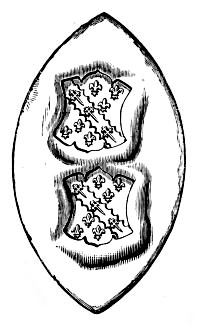
No. 10 occurs in a small signet seal, two impressions of which are attached as a counterseal to a lease by the Priory of Dartford, co. Kent, bearing date 24th December, 1529. This sealing on the back rendered it impossible to detach the large wax seal and apply it fraudulently to another document. This is engraved Proceedings of the Society of Antiquaries, 27th May, 1875.
Occurs also in a brass, Okeover impaling Aston, date 1520 (Boutell's Brasses, p. 127), see No. 75.
Also in another brass, at Sprouston, Norfolk, dated 1559.
No. 11 occurs without the bouche on a chimney-piece at the Episcopal Palace, Exeter, 1486.
With the bouche, in the Ramrage Chantry, St. Alban's Abbey, of about the same date (Boutell's Heraldry, p. 98).
Also in heraldic drawings of 1536, in Willement's Regal Heraldry.
No. 12, but without the bouche, occurs in Henry VII.'s chapel (Archæologia, vol. xvi, p. 194).
The annexed engraving shows a most interesting knightly shield of the Schutz family, of Shotover, co. Oxford, dating from the fifteenth century. It is 2 feet 8 inches long by 1 foot 1½ inches broad, and[61] was, when Mr. Hewitt wrote his book, in the possession of the Rev. J. Wilson, President of Trinity College, Oxford. It is engraved and described, Ancient Arms and Armour, vol. ii, p. 496.
It will be remembered that John of Gaunt's shield, described at p. 29, very closely resembles No. 12.
Nos. 13, 14, and 15.
No. 13 is shown in the seal of the Free School of Richmond, Yorkshire, founded 1535-6 (Gale's Registrum Honoris de Richmond, p. 254).
In an old engraving, showing Henry VIII. and his Parliament, in Hall's Chronicle, published 1548, a shield of this shape appears on the curtain extending behind the throne.
No. 14—In a heraldic drawing, 1558, of the arms of Elizabeth, in Harl. MS. 6096, three of these shields are grouped (Willement's Regal Heraldry).
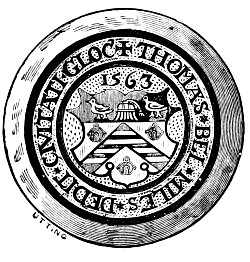
Annexed engraving of an enamelled plaque, supposed to have formed originally the centre of a large salver or dish, is taken from Proceed. Soc. Antiq., 7th Dec., 1876, and shows our shield No. 14 with the date 1563. Sir Thomas Bell died in 1566; he was thrice Mayor of the City of Gloucester, and also represented it in Parliament.
A Scotch seal, Francis Earl of Bothwell, 1587 (engraved Herald and Genealogist, vol. iv, p. 19).
Another Scotch seal, the Earl of Eglinton, 1620 (engraved Herald and Genealogist, vol. iv, p. 18).
Engravings in The English Baronetage, 1741, show the same.
Also in Principal Historical and Allusive Arms, by De la Motte, 1803, which work, indeed, aims at variety in its shapes and designs.
No. 15—In the printer's mark of Ant. du Ry, of Leyden, 1525.
In the shield of Anne Bullen, 1533 (Willement's Regal Heraldry).
Also a seal, 1575, Miscell. Genealogica, vol. ii, p. 170.
These shapes lend themselves particularly to decorations in stained glass, where variations may be constantly found, but it is generally difficult in such cases to give an exact date.
From all which it appears that these shapes—Nos. 13 to 15—began about 1520, and prevailed till about the third quarter of the sixteenth century; and from their beautiful outlines, they occasionally are used even to the present day. During the sixteenth and seventeenth centuries they may often be found hacked and scrolled.
No. 16 occurs in a monument to Raynes, 1689 (engraved in Drake's Eboracum, p. 515).
This is a shape which would lend itself peculiarly to monuments or stained glass.
The shields engraved in Chauncey's History of Hertfordshire, 1700, are of this shape, slightly eared, and very slightly hollowed out in the sides.
Nos. 17 and 18.—In these a decidedly German influence is visible.
They occur in the German book of Virgil Solis, 1555.
The earliest English instance of No. 17 which I have noticed appears in the Visit. Hunts, 1613 (Camden Society), p. 4, with the arms of Clifton, but no exact date is attached.
In the 1724 edition of Guillim's Display similar shields are engraved, with scroll work round the edges.
Nos. 19, 20, 21, and 22.
No. 19 is found on the tomb of Margaret, Countess of Richmond, in Westminster Abbey, who died 1509 (Sandford's Genealogical History, p. 326), see No. 73.
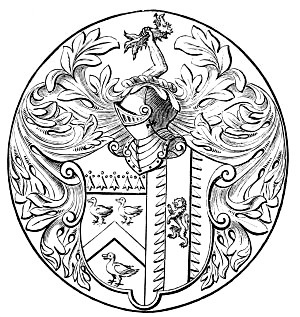
Again in a ledger tomb at Brent-eleigh, in memory of Mrs. Sawyer, and dated 1734 (Miscellanea Genealogica et Heraldica for January, 1886).
Also in the engravings in Blomfield's Norfolk, 1739, with a shaped base.
No. 20, may be seen in stained glass, in Grappenhall Old Rectory window, of date about 1527.
Again in a brass in Antringham Church, Suffolk, dated 1562.
No. 21, a brass at St. Mary Quay, Ipswich, 1525 (Boutell's Brasses, p. 132).
Also on a seal, 1575 (engraved, Miscell. Genealogica et Heraldica, vol. ii, p. 170).
Also on a seal, 1578, in Oliver Vredius (Seals of the Counts of Flanders).
Again in a grant of arms, 1715 (Miscell. Genealogica et Heraldica, second series, vol. i, p. 188).
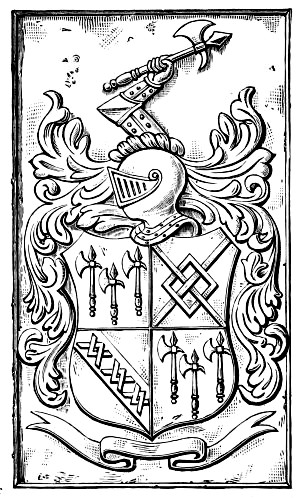
A ledger at Kelston churchyard, Gibbes quartering Harrington and Specott, 1730 (engraved in Miscellanea Genealogica et Heraldica for Jan., 1884).
Thus showing that its present use so extensively by the College of Arms is a return to an old pattern existing at any rate since 1509.
Shields very similar occur in The Ancient Order of Prince Arthure, published by R. Robinson, 1583; also in Sylvanus Morgan's Sphere of Gentry, 1661; while the College of Arms shield No. 22 appears in the Great Seal of Edward VI., 1547.
This group, therefore, extends from about 1500 to the present day.
It is convenient to take Nos. 23 and 24 Stuart, together with 25 and 26 the Georgian.
No. 23, the annexed seal of Robert Greysbrooke of Middleton, is appended to his will, dated 1st September, 1668, and printed Miscell. Genealogica et Heraldica for 1878.
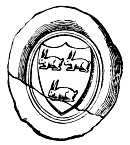
It appears very constantly in seals from about 1610 to 1694.
The shape is used in Sir Peter Leycester's Historical Antiquities of Cheshire, published in 1673.
Again in Sylvanus Morgan's Sphere of Gentry, published 1661.
No. 24 appears in stone carving at Penshurst Place, Kent, showing the arms of Edward VI., 1547. The side points are curled round, and the centre one is capped with a fillet and half globe: an improvement by the stone cutter (Willement's Regal Heraldry), see No. 77.
It is found in the seals and in the crown-pieces of the Commonwealth, dated 1650.
Taking then the Georgian No. 25—In Willement's Regal Heraldry, the arms of Henrietta Maria, the wife of Chas. I., 1625, are reproduced in this shape.
It becomes very frequent 1783-92, and up to 1806 in monuments and book-plates—see page 56.
The shield is used in a work published at Worcester 1795, Historical Anecdotes of Heraldry and Chivalry.
Very many of the bulky seals so common during the last thirty years of the eighteenth century display coats of arms on shields of this shape, which seems to have been much used about this date. The Liverpool halfpenny, 1791, see No. 78; the Leeds halfpenny, 1791; and the Cronebane halfpenny, 1789; and no doubt many other copper tokens show No. 25.
No. 26 is figured by Randle Holme (Academy of Armoury, 1688), who took it from Sylvanus Morgan's Sphere of Gentry, 1661. He explains it is from old and decayed monuments. It is really adapted from ancient shields, which were used by the Amazons, and they are constantly represented with such shields and with double-headed battle axes on Greek coins (see Petiti de Amazonibus Dissertatio, 1687, p. 180, &c.)
The only change noticeable in these shields is that the Stuart, which extended down to certainly as late as 1694, have perpendicular sides,—with an occasional exception, as that quoted 1625,—while in the Georgian the sides are always more or less bulged out.
Nos. 27, 28, 29, and 30, with which may conveniently be taken the tops, designated "eared couped."
No. 27—This shape occurs in Brussels tapestry, dated 1610. The sides are more hollowed-out, and the ears more projected (Jacquemart's History of Furniture, p. 102, English translation).
Very frequently in ledger tombs, 1718, 1749, 1750, and in 1680 (see Miscell. Genealogica et Heraldica, November, 1884, p. 172).
In a MS. dated 1710;
Also in the Radcliffe book-plate, circa 1720, engraved in Mr. Rylands' Notes on Book-Plates, 1889, p. 30.
No. 28—The arms of Caroline of Brandenburg, wife of George II., 1727, are given on this shield in Willement's Regal Heraldry.
No. 29—Several of the engravings in Guillim's Display, edition 1724, and in The English Baronetage, 1741, partake of this character, thus giving a range from 1610 to 1741 for this group.
No. 31 is a shield very extensively used in Germany and Holland.
It first appears in the seals of the Counts of Flanders (Oliver Vredius) in 1477 and 1487, and disappears in 1602.
It is figured fo. 1b in the Nuremberg Chronicle, published 1493.
It may be constantly found at all dates, and down to the present day in German heraldry.
Nos. 32, 33, and 34.
No. 32—This shield has a very extensive range of date; the first I have noticed is on the tomb of Anne of Cleves, in Westminster Abbey, 1539 (engraved in Willement's Regal Heraldry).
Engravings in an illustrated edition of Ariosto, printed Venetia, 1572, repeat the same shape.
In Bolton's Elements of Armories, 1610, where such arms as those of Paracoussi, King of Plate, The Navatalcas, early Mexicans, and the Incas of Peru, are placed in such shields.
The sixpences and York half-crowns of Charles I., 1614, and the arms on his Great Seal, 1627 (Sandford's Genealogical History, p. 515).
In a MS., 1652, reproduced in Miscell. Genealogica for January, 1885, p. 204.
The Great Seal of Charles II., 1653 (Sandford's Genealogical History, p. 517).
The seals of the Commonwealth in 1651 and 1656.
Engravings in Bisse's edition of Nicholas Upton, published 1654;
Also in Sandford's Genealogical History, 1677.
In the seventeenth and eighteenth centuries, seals with this shape are common enough, many of most beautiful execution, supported by cornucopiæ, fruit and flowers issuant therefrom; these extend from 1670 to 1700. We need only look at our Britannia's shield in a modern penny to see the same, adapted from that coin of Antoninus Pius where occurs the first representation of the figure of Britannia, A.D. 138.
No. 33.—The earliest I have noted is on the seal of Sir Thomas de Bikenore, Knt., attached to a charter, s.d., but about 1300; this is engraved Archæolog. Cantiana, vol. ii, p. 41.
It occurs upon the seals of the Counts of Flanders from 1403 to 1623 (Oliver Vredius); it also appears elsewhere in his work.
It is also on the tomb in Maidstone Church to John Wotton, 1417 (Arch. Cantiana, vol. i, p. 181).
It may be seen in the printer's mark of Richard Pynson, 1530.
I have also noticed No. 33 in one of Camden's grants, dated 2nd May, 1608, to James Master of East Landen, Kent: this is engraved Archæologia Cantiana, vol. v, p. 238.
No. 34 is, I think, chiefly restricted to foreign seals and engravings. I have not, so far, noticed an English example.
Nos. 35, 42, and 43.
No. 35—Egg-shaped may be regarded very much as a variation of No. 32, some artists considering it more graceful and better adapted to hold the arms and leave less of the field vacant. The shield of Edward the Black Prince, preserved at Canterbury, and already noticed at p. 30, was of this shape. He died 1376 (Bolton's Elements, p. 67).
But there is a large number of such seals as may be described egg-shaped, with hollowed-out sides, and frequently framed in scrolls; these are classed as cardioid Nos. 42 and 43, the outlines having been altered by scroll work, although sometimes the scrolls are omitted.
These occur in Divi Britannici, by Sir Winston Churchill, 1675;
In monuments of 1684, &c., in Blomefield's Norfolk;
And of 1699, Miscell. Genealogica et Heraldica for December, 1884, p. 185;
Again in 1715, Herald and Genealogist, vol. ii, p. 230; and they are constantly to be found in monumental tablets.
Very frequently the bases of shields with hollowed-out sides are turned either to dexter or sinister, as noticed in seals throughout the eighteenth century; and in some later Jacobean, and in Chippendale book-plates say from 1720 to nearly the end of the century.
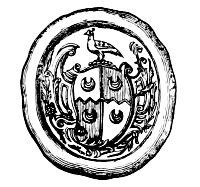 |
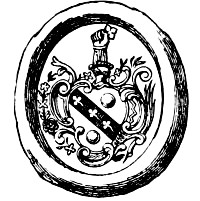 |
| Seal of Bartlett of Marldon and Exeter, co. Devon (Miscell. Genealogica et Heraldica for June, 1887). | Seal of Joseph Palmer, King's Messenger: born 1683, died 1759 (Miscell. Genealogica et Heraldica, second series, vol. i, p. 86). |
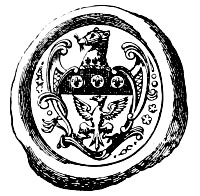 |
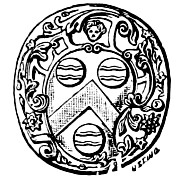 |
| Seal of Michael Grazebrooke of Audnam: born 1723, died 1766 (Miscell. Gen. et Heraldica for 1878). | Seal of Joseph Siket to his will, 1758 (Herald and Genealogist, vol. iii, p. 316; also vol. vi, p. 211.) |
No. 36—French shields, so constantly represented in French heraldry, appear also in English grants of arms, 1557, 1561, 1582, 1612.
This is just an ordinary square shield, No. 7, with a pointed French base.
This shield, however, may be found at much earlier dates—see remarks on Simon de Montacute's seal to the Baron's letter, 1301, on p. 22; also the[70] very curious brass formerly in St. Nicholas' Church, Lynn, to Thomas Waterdeyn, Mayor of Lynn in 1397 and 1404. This shows two shields, No. 36, which bear his merchant's mark, and stand on either side of a tree. He was alive in 1410 (see engraving, Archæologia, vol. xxxix, p. 505).
No. 39.—This curious Italian shield occurs in Gerard Leigh's Accedens of Armoury, 1562.
Also with curious scroll-work, dated 1589, in a timber house at Norwich, engraved, Archæologia, vol. xvi, p. 194.
In the Great Seal of Charles I., 1640, Sandford's Genealogical History, p. 516.
In the halfpenny of Charles II., 1660.
In the halfpenny of James II., 1685.
Randle Holme, book i, p. 6, would have us believe this was "the veritable shape of the Christal shield given by the goddess Minerva to Perseus, to enable him to slay the Gorgon Medusa, and which was after dedicated to Pallas," and this conceit may account for a monster's head introduced in the Great Seal of Charles I., 1640.
Grotesque shields, somewhat of this shape, are given to Ancient Britons, as in Speed's Theatre of Great Britain, 1676, and in MS. pedigrees of early seventeenth century, for the arms of Welsh princes and early potentates. Randle Holme (Academy of Armoury) gives one of these as from the monument of Mahomet, Emperor of Turkey, and another from the monument of Tamerlane, Emperor of Tartaria.
Nos. 40 and 41 actually do occur frequently in Roman bronzes and monuments, and are reproduced in engravings in Bolton's Elements of Armories, 1610, p. 147, &c. Bolton explains that it (41) occurs on the Column to Antoninus at Rome, but later discoveries have shown that this column was really erected to Marcus Aurelius Antoninus in 174 A.D.[71]
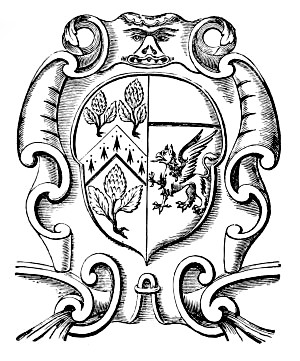
Nos. 42 and 43 cardioid shields (see the remarks upon 33, 34 and 35).—I think these arose from the decorative scroll-work placed around egg-shaped shields, and especially in late Jacobean and Chippendale times, when they may be found in monuments and book-plates. The earliest mural tablet I have noticed is dated 1699, at Winchester Cathedral. This is engraved Miscellanea Genealogica et Heraldica for December, 1884, p. 185.
The engravings in Divi Britannici, noticed under the variations of 35, nearly approach these.
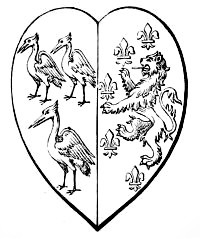
Instances of pure heart-shaped shields occur in the brass to Willem Wenemaer, slain 1325. This is in the vestibule to the hospital which he founded at Ghent (Archæological Journal, vol. vii, p. 287);
Also in a monument at St. Margaret's, Hertford, 1691-2, shown in the annexed illustration. This is from Miscell. Geneal. et Heraldica, January, 1887, p. 197; and the shape may also be found at later dates.
My readers will also refer to that very interesting seal of Richard Basset, about 1145, described at p. 13, and No. 44: it is heart-shaped, greatly lengthened out.
A very curious heart-shaped shield, with the point turned round and scrolled, appears in the wooden effigy to one of the family of Oglander in Brading Church, Isle of Wight. This is supposed to be of sixteenth century. It is engraved in the Anastatic Drawing Society's vol. for 1883.
A curious instance of the recrudescence of early forms occurs when Sylvanus Morgan, vol. i, p. 27, places the arms of one Gill in a triangular shield, such as we noticed in the thirteenth century, and figured No. 1 in the sheet.
Again, heater-pear shields, No. 6, frequently occur in early monuments, as they accorded well with the style of decoration—see the monument to Henry Willoughby, 1581, at Wollaton (Thoroton's Notts, p. 27); also that to Richard Mansfield, 1624, at West Lake Church (Thoroton, p. 27); also that to Thomas Atkinson, 1661, at Newark-on-Trent (Thoroton, p. 200); also in a monument to the Clifton family, about 1670, engraved p. 61 in the same book.
It would be possible to give much more fully the exacter history of several of these shields, showing their various slight variations prevailing at different dates, but such would extend my "attempt" beyond a convenient length.
I have, however, selected one of the most common occurrence, feeling sure that its history will therefore be the more interesting. In A Glossary of Terms used in British Heraldry, published by Parker, Oxford, 1847, the date 1724 is given as the "earliest shield that has been noticed of this tasteless, though still prevalent form," No. 81.
Now, here is the exact sequence with the small variations which I have been able to trace:—
No. 79—Occurs in a book printed by W. Rastell in 1533, quoted in Parker's Glossary.
In an inlaid chimney-piece at Bolsover Castle, with the arms Cavendish impaling Ogle, and therefore the date is 1590-1600.
Also in a MS. pedigree of Howard, date 1580, in the possession of Col. Crosse at Shaw Hill, co. Lancaster.
The next instance I have found is carved on a pew in Warrington Church, and bears the inscription "Richard Massye, 1617." This shows arms quarterly, (1) Rixton of Rixton, (2) Mascy of Rixton, (3) Warburton (?), see Historic Society of Lancashire and Cheshire vol. xxxix, p. 154, where this quartering is discussed; (4) Horton of Horton.
The same shaped shield appears in a monument to Richard Wiatt, who died in 1619. This stands in Isleworth Church, and is engraved in Herald and Gen., vol. iii, p. 500.
No. 84—Is frequently found in MSS. about 1620. I can refer to the pedigree of the Holland and Dukenfield families, which is dated 1622.
The same shield is used in Bysse's edition of Nicholas Upton, which was published in 1654.
Also in a certificate of arms by Segar Garter, 1625, Historic Society of Lancashire and Cheshire, vol. xxxviii, p. 72.
It is also carved in oak in Prescot Church, with the arms of Ogle of Whiston quartering Bertram, and the date 1650.
It again occurs on the gravestone of Richard Clegg, Vicar of Kirkham; the earliest date on which is 1677 (Chetham Society, vol. xcii, p. 128).
The same, but more slightly eared, occurs frequently with the dedicatory arms of the donors of the plates to Sandford's Genealogical History, published 1677.
A ledger stone, dated 1690, with the ears still less strongly marked, is engraved Miscell. Genealog. for February, 1885, p. 242.
No. 82—Occurs in a grant of arms, dated 1684, Miscell. Genealogica, second series, vol. i, p. 397.
The same shield appears in a grant, dated 1696, printed in the same work, first series, vol. ii, p. 191.
Such shields with very slightly marked ears, and with pointed or angular, also with French bases, are found very frequently in book-plates of 1700 and for ten years or so later, and sometimes with the sides very slightly hollowed-out.
No. 83—Is a shield with Queen Anne's arms, 1706, engraved in Willement's Regal Heraldry.
No. 80—May be seen in the monument to Tho. Norreys, 1624, in Rainham Church, Kent (Archæologia Cantiana, vol. vi, p. 295).
A grant of arms, dated 1720, is engraved in Miscell. Genealogica, vol. ii, p. 252, and shews the same shield.
Seals about the year 1718 appear with this same shape, of rather broad proportions, and with French bases rather flattened.
No. 81—In Wright's edition of Peter Heylin's Helps to History, published 1773, this variation is used, but of rather longer proportions.
About 1780, seals are noticed to follow the same character, and with angular or French bases, just as we see them prevailing even to the present day.
This shield therefore, with slight variations in the ears, may be found from 1533 to the present day; and the date given in Parker's Glossary was fixed upon insufficient research.
Counterseals
in England are usually of the same shape and size as the seal proper; the pendant cake of wax thus showing two complete impressions, one on each side.
Edward the Confessor and his successors have continuously used them; but among subjects they do not appear before 1130—excepting, perhaps, that remarkable instance of two seals conjoined back to back on the charter of Odo, Bishop of Baieux in 1075. See Archæologia, vol. i, p. 335.
Nobility of the blood royal, their wives and daughters, seem to have used counterseals pretty generally from the middle of the twelfth century. The greater titular nobility also adopted them occasionally during that century; but in the next, and until the Baron's letter (1301), a much larger number occur. Their use, however, was very irregular: many prominent titular nobles neglected them, and, on the other hand, we find many families of only moderate territorial position placing secreta on the back of charter seals. I notice as quite remarkable how many ladies who had come to represent a manor, about the middle of the thirteenth century, when the fashion was at its height, at once beautified or safeguarded their seals with a secretum.
After 1301 such extra sealing almost disappears, but there are some very late instances. Humfrey Earl of Stafford and Perche, 1438, placed on the back of his splendid seal a smaller one—the Stafford arms on a heater shield, within a decoration of three Stafford knots, but without any inscription (Archæologia, vol. xxxviii); and some of those large and pretentious seals mentioned as appearing 1450-1475 were used with small counterseals.
Many ecclesiastical communities used counterseals, also the old Cinque ports and other ancient boroughs. Ancient official departments too, such as the Norwich Staple, 1272-1307: these having begun, of course continued their use as an established form.
Secreta
were usually small, and inscribed "Secretum." The first I have noticed is that of Seherus de Quenci, created Earl in 1210—"Secretum Comitis Wintonie." (Spelman's Aspilogia, p. 67.) John de Busli, however, is even a little earlier; "Secretum Johannis de Bueli" (The Earls of Eu, by Chester Waters, p. 33).
After a careful examination I have come to the conclusion that no regulations restricted their use, but counterseals and secreta were adopted or not, according to taste. Some regarded them as an accession of dignity, and some as a safeguard: there seems no doubt it was for the second reason that that signet was placed, in 1529, on the back of the Dartford Priory Seal (see p. 60); and I find another instance, where a seal of the same Priory, in 1534, had as a counterseal the impression of a small signet with the letters I F, being apparently the initials of Isabel or Joan Fane, the prioress at that time.
It will give some idea as to the prevalence of counterseals if I say that to the Baron's letter, 1301, are appended ninety-five seals of the principal nobility. Seventy-nine have no counterseals: to sixteen such are attached; namely, eight of the same size as the seals, and eight greatly smaller. Two of these smaller ones are not inscribed (William de Brehouse and Simon de Montacute), and one only is called "Secretum" (Walteri de Teye). I think this shows they were less commonly used in 1301 than about 1250.
Mantlings from the Sixteenth to the Nineteenth Century.
It is somewhat difficult to treat distinctly of the mantlings prevailing since the beginning of the sixteenth century; but as they afford indirect evidence of date, I venture to draw up the following short description of their variations; and I do so with some diffidence, in the hope that fellow-students may add to my feeble effort, and that thus we may presently arrive at a perfect and dated scheme of these changes.
I am obliged to treat seals separately from drawings and stone carvings, because the circumscribed space in a seal seems to have prevented some of the variations noticed in the others. At the same time, several characteristic changes are found to occur, and at tolerably distinct dates; and so it is possible to lay down very clearly, as to seals, the current of progressive change.
By far the greater number of heraldic Seals at the beginning of the sixteenth century have no mantling, but display only a bare shield, without ornament—unless some scroll-work or architectural lines, to fill up the space within the dotted or plain circles. Such seals occur constantly till the end of the seventeenth century.
About 1550 helmets with mantlings, open and rather sparse, and kept high up on the top of the shield, appear. These mantlings are rather flat, so that a good space is left for the crest, which thus stands out distinctly. As a specimen, see Wm. Lambarde's seal, 1552 (Archæologia Cantiana, vol. v, p. 256).
Although a good many seals continue still with the mantlings kept up about the top of the shield (while sometimes a motto, &c., is introduced below), it is observed that a little after this date mantlings[78] gradually creep downwards, perhaps to two-thirds of the depth of the shield. See a seal of the Throckmorton family, 1576 (Visitation of Warwick, 1619, Harl. Soc.); also those of Lord Chancellor Bromley, 1581 (Herald and Genealogist, vol. v, p. 5); John Ogle, 1597 (Mascy Charters, plate C, Historic Society of Lancashire and Cheshire for 1887); and Edward Osborne, 1618 (Herald and Genealogist, vol. iv, p. 241; also Archæologia Cantiana, vol. v, p. 234).
This is the character of many examples occurring down to about the year 1650, when a greater profusion of mantling began to be shown: of this the seal of Sir Edward Nicholas, engraved on p. 45, is a good example; and it is the first instance I have noticed in which the folds of the mantling come out from behind the shield, thus marring its distinctness. Usually, although the volume of foldings increases, they are kept away from it, so as to leave the impression of the shield standing out and quite clear. In this, too, the folds extend higher up on either side of the crest than is usual in earlier examples.
It may be interesting here to note that of the fifty-nine seals attached to the death warrant of Charles I., in 1648-9—following the very accurate engraving in Monumenta Vetusta, vol. ii,—twenty-one show mantlings, eleven are distinctly without, ten are doubtful, and the remaining seventeen seals are quite illegible.
From about 1650 many beautifully cut signets are found—the arms, with helmets, crests, and mantlings, the points of which rise up on either side of the crest, thus filling up that empty space. The seal of the Cordwainers of Oxford, made in 1680, is a favourable example of the date (Arch. Journal, vol. vi, pp. 159 and 279).
About 1680 I have observed tassels sometimes appear as a finish to the lower ends of mantlings,[79] as in the seal of Thomas Bate, engraved on p. 45; also in a signet of 1683, in Miscellanea Genealogica et Heraldica for 1886, p. 143; and elsewhere.
Shields set in frames of scroll-work, without mantlings, were prevalent from the beginning of the seventeenth century. For an example, see a signet of Fetherston, 1638, engraved in the Visitation of Warwick (Harleian Society).
From about 1670 cornucopiæ, with flowers, &c., appear, supporting shields more or less egg-shaped; and some of them are most exquisitely engraved. But even at so late a date, I have not observed tincture lines introduced.
I have noticed very few seals about this time in the Jacobean taste. Probably no room was left in so confined a space for scroll-work around the base of the shield. But mantlings—rather heavy, although not voluminous, and kept up pretty high—are found towards the end of this seventeenth century. In many cases also, at this time, plain Georgian shields occur, without mantling.
Early in the eighteenth century seals are found in late Jacobean frames, open and with trellis-work, adorned with rushes and flowers, and without mantlings.
The influence of Chippendale taste strongly affected seals from about 1750 to 1775.
Many followed in the style of Adam, with ribbons and festoons of flowers, and sometimes lightly scrolled frames. These, of course, are without mantlings.
We are thus brought to the end of the eighteenth century. Only occasionally have I met with mantlings between about 1740 and 1800; but I must explain that it is very difficult to get together a body of examples of the eighteenth century: such are not old enough to be figured in engravings, and documents likely to bear them are not of sufficient interest to be examined for any other[80] purpose. I trust fellow-students who read this book will sketch, with their dates, all instances of this epoch: it is only in that way we can get together a body of evidence.
It seems to have been very common, also, for successive generations to repeat the style of their seals, as if that were as important as the heraldry displayed; and thus instances of the several variations occur, perhaps, much later than their legitimate dates—as classified above, from many examples. I know one family whose seals from 1718 to 1840 show, with only one or two exceptions, "the tasteless though still prevalent form" No. 80, and without any mantlings.
Although taking Drawings and Stone Carvings together, there are certain differences observable in each; for instance, we constantly find, in monumental sculptures of the sixteenth century, designs with mantlings above and scroll-work below, which very closely correspond with Jacobean book-plates and engravings such as did not appear till about 1720. I would refer to Thoroton's History of Notts, p. 227; where is engraved a monument, at Wollaton, to Henry Willoughby, who died 1581, which is quite Jacobean in taste and treatment. Another equally so is at Newark-upon-Trent Church: this was erected in 1661, to Thomas Atkinson (Thoroton's Notts, p. 200). Another with cornucopiæ and scrolls stands in West Lake Church, to the memory of Richard Mansfield, who died 1624 (Thoroton's Notts, p. 27). This last exactly corresponds with some of Hollar's beautiful designs, in Sandford's Genealogical History, published in 1677; and it is very remarkable that these are a distinct advance upon Hollar's own designs in the preface and dedication to the Bysse edition of Nicholas Upton, which he engraved in 1654; while for nearly fifty years this monumental example had stood in West[81] Lake Church, and we know it was only one of many similar English works. I have many times noticed that sculpture precedes engravings or paintings. It is, I think, inherently so: designing in the round comes first, to be afterwards translated, by skilful and artistic and educated shading, into the flat.
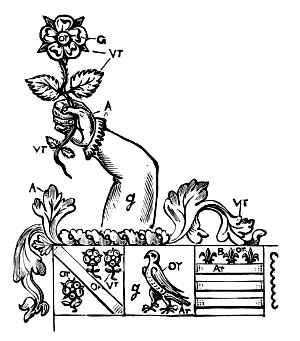
Through the kindness of Dr. Jackson Howard, Maltravers Herald, and Messrs. Mitchell and Hughes, I am able to shew the engraving (from Miscell. Genealogica et Heraldica for 1884, p. 99) of a very unusual mantling from the Confirmation of Arms in 1526, by Thomas Hawley, Clarenceux, to Francoys Galuerdet, a native of Rhodes, and Receiver General in England for the Hospital of St. John of Jerusalem. This mantling is unusually small; there is no helmet, and the torce is beautifully worked [compare the brass to Sir Wm. Say, lithograph No. 71]. I put this forward first because of its early date, and it seems that at this time mantlings in heraldic drawings, grants, &c., were kept very small.
It will be convenient to describe, and in a numbered list as follows, the variations observed at successive dates.
1.—From 1550 to 1570 there is a tendency to keep the greater portion of mantlings above the[82] shield. They are of smaller volume, and one fold is allowed to wander down on each side, ending in a tassel about one-third down the depth of the shield. A very characteristic example is engraved in Miscell. Genealogica et Heraldica for June, 1887, being the grant to Thomas ffletewood, of London, 1st June, 1545. In the grant to John Lambard, 15th January, 1551 (engraved in Archæologia Cantiana, vol. v, p. 247), such a mantling has four tassels, two above carried up somewhat high, and two below standing about one-third down the shield. The mantling to the arms of Goodricke, engraved in Gerard Legh's Accedens of Armory, edition 1562, is of the same character, but without tassels.
2.—A little later the number of folds is observed to increase, and the tassels are carried down further and turn inwards towards the base point of the shield.
3.—In a grant dated 1572, which is printed in Miscell. Genealogica et Heraldica, vol. i, p. 321, occurs the first instance I have noticed of the foldings coming from behind the shield, and the same may be seen in a grant of 1575, printed in Sylvanus Morgan's Sphere of Gentry, lib. ii, p. 74.
4.—From about 1590 to 1630 a return to the simpler style is observable; a single fold wandering away from the body and reaching with tassels to the base of the shield. Occasional instances return wholly to the descriptions given under 1 and 2.
5.—After about 1620 the volume of mantling gradually increased, and seemed to be purposely so arranged as to come out from behind, probably because it was found in drawings to give artistic relief to the shield.
6.—By about the year 1670 mantlings are frequently found of excessive volume, and in a mass, which would be solid were it not skilfully broken by[83] lighter hackings appearing in the central portions; the folds come down in heavy masses, sometimes like great sausages or cucumbers, to the bottom of the shield. Examples of such may be seen in Sandford's Genealogical History, 1677, and in book-plates engraved in Miscell. Genealogica et Heraldica, December, 1886, p. 184, and elsewhere. The skill of the artist affects wonderfully the quality of these designs; it is not only the chiaro-oscuro, but the turning of a line may often sparkle with genius. Sometimes they are extremely flat and heavy, for instance, in the map attached to Thoroton's Notts, 1677, may be seen a specimen, which is a great contrast to Hollar's designs in Sandford's Genealogical History, published in the same year. Again, the frontispiece to Carter's Honor Redivivus, published in 1673, shows flat waves, and behind the shield, coming out two-thirds down its length, the edges rippling into leaves and hackings, while the folds extend down to a boldly hacked and curled cartouche for the motto, out of which spring two branches of olive.
Instances of this style continue to occur down to 1750. We find them so engraved in Guillim's Display, 1724, also in the English Baronetage, 1741, and in some of the engravings in Atkyn's Gloucestershire, 1768.
7.—About the year 1700 appeared for a few years, perhaps we may say till about 1720, book-plates and dedicatory arms with great hacked foldings twisted round and looking something like Catherine-wheel fireworks. Two or four of these occur in book-plates, and sometimes as many as six, three on each side. We notice that these are conventional exaggerations of the less pronounced circular foldings and turnings seen so early as 1677 in some of Hollar's engravings in Sandford's Genealogical History. An engraving at p. 185 in[84] Chauncey's History of Hertford, published in 1700, is especially interesting; it shows a monument, dated 1662, to Hewytt, in Sawbridgeworth Church, where the carver has struggled to avoid the long ugly folds ("cucumbers"), and has introduced very vigorously twisted leaves and hacks which almost approach those conventional Catherine-wheel fireworks as found in book-plates of a later date, say from 1700 to 1720. I would point out that all the armorial engravings in Chauncey's Herts are well worth studying: the mantlings are hacked all over, and extend about four-fifths down the shields in endless small and vigorous twists, the shields themselves being variations of No. 16. Some of the engravings in Plot's Natural History of Oxfordshire, published in 1705, show the same character, also some of those in Atkyn's History of Gloucestershire, published in 1768.
8.—The rebound from this taste led to small mantlings, kept a good deal at the top of the shield, even although there were no supporters, as in a peer's coat of arms, to prevent their downward flow. These occur also when the bases of the shields in Jacobean book-plates are finished off with scroll work, trellis, scales, &c., &c.; the upper part of the shield being ornamented with such smallish mantlings. In Blomefield's Norfolk, 1739, ribbon scrolls extend all round some of the shields in the place of a mantling; while in what is, I suppose, a book-plate, Holland impaling Upton, printed in the pedigrees at the beginning of vol. i, acanthus leaves occur in the base, and break out occasionally, where convenient, from such scrolls, which are arranged round the upper part of the shield. Scrolls are strictly architectural ornaments, and not vegetables. These correspond to the French style called "Bombé," in which curves and undulations of surface in ribbons, &c., were rolled[85] and tossed about for artistic effect. But with our English examples of monuments of the sixteenth century in the same taste (see p. 80), we need not consider that our Jacobean style was borrowed from the French, although that nation, for a full century, ending in 1790, guided the artistic tastes of Europe.
9.—During the Chippendale fashion all martial elements disappear, helmets and mantlings are swept away, and we see the style of Louis XV. borrowed from the prevailing French taste, broken shell-shaped woodwork, rocks, and shell curves (rocaille coquille), hence called "Rococo." It was well enough in the frames of mirrors and furniture, but seems strangely out of place around a cardioid shield of arms, with festoons of flowers and spikes of reeds or grass, while perhaps Cupids or Greek vases on brackets are introduced. Nevertheless, the genius of Chippendale sublimated this into specimens of great beauty. Chippendale's Books of Designs were published in 1759, i vol., folio, and in 1762, i vol., folio.
10.—Mantlings, of course, continued to be shown in grants of arms. We find about 1775 they appear to be smaller again, and confined to the top of the shield, often being carried rather high up on each side of the crest, and frequently ending at the base in two tassels [see a grant 1779, Miscell. Genealogica et Heraldica, second series, vol. iii, p. 41].
11.—This style continued to the beginning of the nineteenth century, when I have observed very light and graceful mantlings thrown about in airy and much hacked foldings, and generally ending in tassels (see a grant 1803, Miscell. Genealogica et Heraldica, original series, vol. ii, p. 20). This character is also seen in many book-plates of this date.
12.—I must now say a few words on the style introduced and skilfully enforced by Robert and James Adam. They, too, adopted from the French, and by their skill and artistic taste developed to great perfection the style of Louis XVI. (1774-90). The rage for this fashion arose in Europe upon the discovery at Pompeii of Roman frescoes preserved in their original colours. The brothers Adam caught the exact spirit of these, and produced heraldic designs, consisting of shell-fluted scrolls, with light and airy festoons of flowers and ribbons, surrounding shields almost invariably Georgian No. 25. The festoons were frequently extended in graceful curves, from pegs, just as we see them in the recovered Roman arabesques, or on the walls of the Petit Trianon. Robert and James Adam published their book in three vols., imp. folio, 1773-1822. For examples of this style see Dugdale's Warwickshire, 1765; Hutchin's Dorset, 1774; Hasted's Kent, 1778; Rudder's Gloucestershire, 1779 (one specimen only); Nichol's Leicestershire, 1795; Shaw's Staffordshire, 1798; Manning and Bray's Surrey, 1804. This long list will show how extremely popular the Adam style continued to be for about thirty years.
13.—As early as 1500, a fan-shaped mantling with rounded base appears; it was formed of an unhacked cloth with many closely folded rays, and occasionally two tassels are attached to the upper corners and hang down as supports on each side of the shield, which stands in the middle—see examples engraved in Herald and Genealogist, vol. viii, p. 247; Archæologia Cantiana, vol. v, p. 248; Miscell. Genealogica et Heraldica, first series, vol. ii, p. 100; &c., &c. This design is continued until after 1700, but seems less closely folded at the later dates, when they are often found in ornamental achievements in pedigrees.
14.—A curious example of a mantling is engraved Herald and Genealogist, vol. viii, p. 254, in which a square sheet or cloth, having no hacking, and attached to the helmet, is folded-in round the edges; through these a cord is passed, ending in two tassels which extend a little below the bottom of the mantle. This portion of the cloth, as well as the back, hangs down straight without any folds. The result is that the shield stands out against the deeply shaded back ground within these folded-in edges, they being in high light. The MS. from which this is taken is dated 1645, and the shield displays the arms of Helsby.
15.—The earliest instance I have noticed of those large unhacked square sheets or mantles called by Porney "drapery," which are drawn up through two rings or ribbons at the upper corners and fall in folds, while in the middle stands the shield of arms, occurs in a monument at Holme Pierpoint to the Countess of Kingston, which bears date 1649 (Thoroton's Notts, p. 90). Such are also engraved in the Sphere of Gentry, 1661; and in the English Baronetage, 1741. These are occasionally to be met with down to 1840. In French heraldry they are commonly found.
In Archæologia Cantiana, vol. x, p. 329, is engraved a curious tent-shaped "drapery," drawn over the helm and held there by a ducal coronet, from which starts the crest, while beneath, and in the middle of the sheet, stand the shield of arms and supporters. This is from "The Confirmation of Supporters, Crest and Arms to Sir Edward Dering, Knt. and Bart., by Sir Wm. Segar, Garter." The first baronet was created 1st Feb., 1626, and Sir Wm. Segar died in 1633; so the date of this drawing is within those seven years.
It must be evident that each artist gave a certain character and style of his own to his work; at the same time the various fashions noted above are found strongly prevailing at the dates given. They were what was approved by the public taste, and any variations only extend to more or less skilful working out. It will be noticed that public taste has several times alternated between sparse and voluminous mantlings. There are indications at the present time which seem to point to a return, within a few years, of the massive convolutions seen during the last quarter of the seventeenth century.
In ledger stones and monuments from 1650 the characteristics given above are followed until about 1780, when other kinds of decoration—palm branches, festoons, and scrolls—very largely superseded mantlings.
IMPORTANT NOTE ON TINCTURE-LINES IN SEALS.
My readers would notice at page 52 and again at page 79 that I could not accept the statements that seals so early as 1648-9 could possibly show tincture-lines. I therefore gave my authorities, and showed pretty evidently that I could not, in the face of other facts, accept them. Since the writing of those pages, Mr. W. H. St. John Hope has very kindly examined for me the original document preserved among the muniments at the House of Lords, and reports that in none of the seals attached to the death-warrant of Charles I. are the tinctures indicated by lines. It is not for me to explain how so accurate an observer as the late Mr. Planché made such a mistake. I think it is probable that the late Mr. Bouttell followed him and enlarged somewhat. The fact, however, is now definitively settled.
I had observed that in those earlier printed books which have copper plates, the invention of Father Silvester de Petra Sancta had been very cautiously and undecidedly adopted. In Spelman's Aspilogia [included in that small folio published by Edward Bysse in 1654, and to which I have frequently referred as containing also the works of Nicholas Upton and John de Bado Aureo] most of the shields have tincture lines; but in some of the copper plates, signs of various planets are given instead of those letters for tinctures which are usually seen in "tricks."
NOTE TO PAGE 36.
I have no doubt that the curious projecting point to which the attention of the reader has been drawn, was meant as a protection against the "Coup de jarret," that terrible feat of arms which aimed at severing the muscles behind the knee, a spot necessarily covered by leather only, and therefore peculiarly vulnerable.
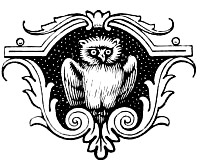

INDEX.
SHIELDS FIGURED ON PLATE I, PAGE 11.
| No. | Pages. |
| 1— | 12, 18, 19, 72 |
| 2— | 12, 14, 21, 24 |
| 3— | Introduced 5, 11, 12, 13, 17 |
| 4— | 11, 12, 17, 24 |
| 5— | 16, 21, 22, 24, 26, 32, 38 |
| 6— | 14, 15, 18, 20, 21, 72 |
| 7— | 22, 24, 38 |
| 8— | 59 |
| 9— | 37, 60 |
| 10— | 37, 60 |
| 11— | 37, 60 |
| 12— | 37, 60 |
| 13— | 61 |
| 14— | 61 |
| 15— | 61, 62 |
| 16— | 62 |
| 17— | 62, 63 |
| 18— | 62 |
| 19— | 63 |
| 20— | 63 |
| 21— | 64 |
| 22— | 64 |
| 23— | 65 |
| 24— | 65 |
| 25— | 65 |
| 26— | 65, 66 |
| 27— | 66 |
| 28— | 66 |
| 29— | 66 |
| 30— | ... |
| 31— | 67 |
| 32— | 67 |
| 33— | 67, 68 |
| 34— | 67, 68 |
| 35— | 68 |
| 36— | 70 |
| 37— | ... |
| 38— | ... |
| 39— | 70 |
| 40— | 71 |
| 41— | 71 |
| 42— | 68, 71 |
| 43— | 68, 71 |
- Adam style, 86
- Animals in the fields of seals, 18, 22, 23, 24, 27, 32
- Bosses in round shields, 4;
- in other shapes, 13, 14, 16
- Bombé style, 84
- Bouches, 16, 24, 31, 37
- Chaplets or Wreaths, 54
- Chippendale style, 85
- Counterseals, 75
- Crosses and other signs beginning inscriptions, 21
- Dates on seals, 43
- Death Warrant of Charles I., 52, 54, 88
- Decorations on the field in seals, 16, 21, 23, 32
- Decline in the style of seals, 27, 30, 33, 44, 49
- Guiges, 6, 21
- Gunpowder, use of, 26
- Helmets, 59
- Inscriptions, style of, given at the end of each century; cross and other signs at their commencement, 21
- Ledger stones, 88
- Lines, dots, ropes, &c., surrounding seals, 21
- Mantlings, 39 to 43;
- sixteenth century and later, 77 to 87;
- fan-shaped, 86;
- square sheets, 86, 87
- Mottoes, 58
- Palm branches, 55 [92]
- Rococo style, 85
- Seals sometimes used for a long period, 9, 29;
- lines, dots, ropes, &c., surrounding, 21;
- time required in making, 27, Note;
- decorations on the fields, 16, 21, 23, 32;
- animals in fields of, 18, 22, 23, 24, 27, 32;
- inscriptions, crosses, and other signs at their beginning, 21;
- unfolded scrolls in, 32;
- counterseals, 75;
- secreta, 76;
- dates on seals, 43;
- decline in style of, 27, 30, 33, 44, 49
- Secreta, 76
- Shields, round, 1, 26, 36, 38;
- laws relating to, 2;
- heart-shaped, 13, 15, 71;
- eared, 73 to 75;
- square, 5, 19, 20, 38;
- lozenges, 20;
- turned round at base, 14, 69, 72;
- curved outwards, 24, 33 to 36;
- curious point in sinister base, 36, 89;
- John of Gaunt's shield, 29;
- the Black Prince's shield, 30;
- length of shields, 4, 7;
- their use abandoned in war, 8, 24 to 26;
- introduction of gunpowder not the cause, 26;
- bosses in round shields, 4;
- in other shapes, 13, 14, 16
- Sources of information, 9, 49
- Supporters, 56
- Targetiers, 5
- Tincture lines, 52, 79, 88
- Torces, 43, 81
- Wreaths or Chaplets, 54
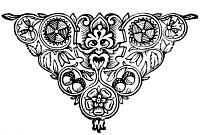

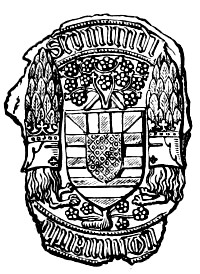
Being deeply impressed with the great value of a "Corpus Sigillorum" which would bring together in one view a large number of English Seals of each century for the eye to rest upon and so to comprehend the varying styles at different dates, Mr. Grazebrook puts forward the following proposal to see if a sufficient number of Subscribers will be found to support him, and meet the heavy expense of producing such a work. It is obvious that to lessen the number of illustrations would impair its usefulness, and Mr. Grazebrook would not undertake the book unless it can be thoroughly carried out. What he contemplates would show perhaps fifty selected characteristic seals for each century from the eleventh to the seventeenth, displayed in order of date. So large a number would not be needed at the earliest or latest dates, but for some of the periods a greater number ought to be given. Students now get together such collections in tracings and drawings—as the labour of years; and it is feared very few have perseverance enough to carry out fully their aim, but without such exact data conclusions must be guess-work. Mr. Grazebrook has such a collection for his own use, and knows from experience what a great advantage it is.
This proposed well-illustrated book would not only be most valuable and instructive to the Antiquary, it would also possess a far wider and general interest, because these are the highest specimens of Art remaining to us of the early times in which they were made. Seals at all dates are the results of the greatest skill and care to be procured, according to the owner's means; and[94] many of them are masterpieces, both of design and execution. They display the whole career of Art: the simplicity of early times, gradually developing and culminating in the perfection of the fourteenth century; to be followed by overloaded designs, beautified by exquisite workmanship, at the end of the fifteenth.
Such a pictured History of Art could not fail to be interesting and attractive to many who would not care to study the subject from a strictly antiquarian point of view.
This large collection of engravings would be accompanied by explanations giving an account of most of the seals, the origin of their decorations, and other particulars involving a considerable amount of genealogical research; which, even when epitomised, must form a bulky volume; and it would require a large body of Subscribers at 30s. to cover the expense; but the author trusts he may be encouraged by such extended support that he may be able somewhat to increase the number of illustrations—many of which must be reproduced from the copper plates in old and rare works, thus involving considerable expense.
Subscriptions payable when the work is completed.
Gentlemen who would be willing to subscribe will please write to that effect to George Grazebrook, F.S.A., Oak Hill Park, near Liverpool.
Any suggestions for the improvement of the work would be esteemed. The author will confine himself strictly to
The Art History of those seals whose dates are accurately known;
The Characteristic Styles prevailing at each period; and
The various Signs of Date as they are developed.
FOOTNOTES
[1] I have to acknowledge the kind permission to use the following illustrations—by Messrs. Virtue and Co., four blocks from Cutts' Scenes and Characters of the Middle Ages, 1872; by Messrs. Mitchell and Hughes, six blocks from Dr. Jackson Howard's Miscellanea Genealogica et Heraldica; by Messrs. Nichols and Son, sixteen blocks from The Herald and Genealogist, Collectanea Genealogica et Heraldica, The Topographer and Genealogist, and The Visitation of Huntingdon, 1613 [Camden Society]; by Messrs. Parker, eight blocks from Hewitt's Ancient Arms and Armour and The Archæological Journal, vol. iv; by the Society of Antiquaries, eight blocks published in their Proceedings; and by the Royal Archæological Institute, one block from The Archæological Journal, vol. xi.
[2] Randle Holme's Academy of Armoury, book i. p. 9, tells us how Froissart, describing the battle of Poictiers, says that the Black Prince commanded the body of the Lord Richard Duras to be laid on a shield, and that five men should bear the same to the Cardinal of Peregorth for a present, &c. Also, that towards the end of the reign of Edward III, the Frenchmen, to save themselves from the liberal shot of the English archers, had shields made of elme-wood, seven feet in length and three in breadth and an inch in thickness, which were made sharp at the foot to pitch into the ground.
[3] It would be curious to ascertain, if we could, how long the die sinkers in early times required to make these large and splendid seals. I have only noted a few instances which throw light upon it, but, no doubt, a careful search might show the earliest dates after their succession when the several kings used their new great seals. Rymer's Fœdera contains many orderings and surrenderings of such seals; the great difficulty is to connect the impression with the thing ordered or dealt with. Blackstone [The Great Charter and the Charter of the Forest, 4to, 1759, pp. xxix and xliii] informs us that the great Charter of Henry III, dated 12th November, 1216 (he was crowned at Gloucester, 28th October, 1216), was sealed—as declared in the document—with the seals of Gualo the Legate and William Earl of Pembroke; King John's seal having been lost in passing the Washes of Lincolnshire, and no new seal being made for King Henry till two years after. About 6th November, 1218, a new great seal was made for King Henry III, and then began to be used in sealing writs, of course, but was forbidden to be put to anything which might tend to perpetuity till the king should arrive to full age; and a footnote is added, "It has not even in later times been altogether unusual for the successor to defer for a while the making of a new great seal,—and in the interim to use his predecessor's:—The Editor has met with a patent of Richd Cromwell, dated 18 Nov. 1658, [11 weeks after his protectorship commenced] which was sealed with Oliver's seal." Roger de Hoveden notes, under the year 1194, that Richard I. ordered a new great seal to be made, but the earliest deed to which it is known to be attached bears date 18th May, 1198—that is, four years afterwards. (M. Deville's Treatise on the Seals of Richard I., and Archæological Journal, vol. iii, p. 372.) Among the Standish Deeds, which I had lately the honour to lay before this Society, was one—a licence to found a chantry at Standish—granted by Edward III. on 12th February, 1328, and with apparently an unfinished seal. The impression is a bad one, but the lions afterwards on the horse clothing seem to be wanting. He only ascended the throne 25th January, 1327. On the fourth day of his reign, viz., 28th January, 1327, he delivered his great seal to the Bishop of Ely as Chancellor, two fleur-de-lys having been engraved on the under side thereof (Rymer's Fœdera, vol. ii, p. 683). This was his father's seal, thus slightly altered on one side. In October of the same year Edward III. stated by proclamation that he had a new great seal, different on both sides from the seal hitherto used; which great seal was to have authority from 4th October, 1327. Rymer, vol. ii, p. 718, records that the previous seal was broken up in the king's presence, in his chamber in the Castle of Nottingham. See Professor Willis on the great seals of Edward III., a learned paper printed in the Archæological Journal, vol. ii, p. 14.
- Both "torse" and "torce" were used in this book.
- Both "scroll work" and "scroll-work" where used in this book.
- Both "wood-cut" and "woodcut" were used in this book.
- Page 24, "p." changed to "pp."
- Page 26, closing square bracket added after "p. 187."
- Page 39, "15" changed to "by" ("He was beheaded by Edward II.").
- Page 51, period added after "sett to my hand."
- Page 53, "II" changed to "II."
- Page 60, closing parenthesis added.
- Page 67, "cornucopiaœ" changed to "cornucopiæ."
- Page 69, closing parenthesis added after "p. 211."
- Page 74, closing parenthesis added.
- Page 86, "indroduced" changed to "introduced."
- Page 94, period added after "considerable expense."






